HMH Algebra 2 Volume 1 1st Edition Module 5 Chapter 5 Exercise 5.1 Polynomial Functions
Page 234 Problem 1 Answer
It is given an expression 3×3. It is required to classify the polynomial by its degree and number of terms.
The degree of the polynomial is 3. The polynomial has only one term so, it is a monomial.
Thus, 3×3 is a cubic polynomial with one term.
The given expression, 3×3 is a cubic monomial.
Page 234 Problem 2 Answer
It is given an expression 9x−3y+7. It is required to classify the polynomial by its degree and number of terms.
The degree of the polynomial is 1. The polynomial has three terms so, it is a trinomial.
Thus, 9x−3y+7 is a linear trinomial.
The given expression, 9x−3y+7 is a linear trinomial.
Page 234 Problem 3 Answer
It is given an expression x2−4. It is required to classify the polynomial by its degree and number of terms.
The degree of the polynomial is 2. The polynomial has two terms so, it is a binomial.
Thus, x2−4 is a quadratic binomial.
The given expression, x2−4 is a quadratic binomial.
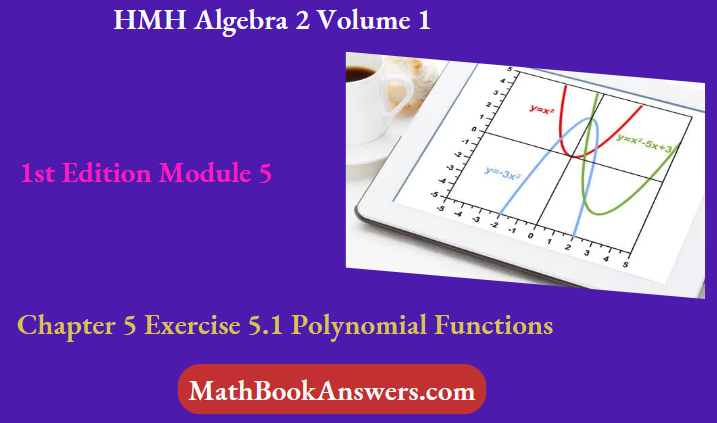
Page 234 Problem 4 Answer
It is given an expression x5+x4. It is required to classify the polynomial by its degree and number of terms.
The degree of the polynomial is 5. Thus, it is a quintic polynomial. The polynomial has two terms so, it is a binomial.
Thus, x2−4 is a quintic binomial.
The given expression, x5+x4 is a quintic binomial.
HMH Algebra 2 Module 5 Chapter 5 Exercise 5.1 Solutions
HMH Algebra 2 Volume 1 1st Edition Module 5 Chapter 5 Exercise 5.1 Polynomial Functions Page 234 Problem 5 Answer
It is given an expression 5x3−7y2+2. It is required to classify the polynomial by its degree and number of terms.
The degree of the polynomial is 3. Thus, it is a cubic polynomial The polynomial has three terms so, it is a trinomial.
Thus, 5x3−7y2+2 is a cubic trinomial.
The given expression, 5x3−7y2+2 is a cubic trinomial.
Page 234 Problem 6 Answer
It is given an expression x. It is required to classify the polynomial by its degree and number of terms.
The degree of the polynomial is 1. The polynomial has one terms so, it is a monomial.
Thus, x is a linear monomial.
The given expression x is a linear monomial.
Page 234 Problem 7 Answer
It is given a functionh(x)=0.25(x−6)3−1 .
It is required to find the new function after the transformation of 10 units left, 7 units down.
To find the required transformation identify the inflection point then transform it as per given instruction, for x a xis the right direction is positive and left direction is negative, for y
axis up direction is positive and down direction is negative.
The inflection points on h(x)=0.25(x−6)3−1 is (6,−1).
Now, the transformation of 10 units left is (6−10)=−4.
The transformation of 7 units down is (−1−7)=−8 as the downward sides of y axis negative.
Now, the transformed inflection point is (−4,−8).
The new function after transformation ish(x)=0.25(x+4)3−8.
The new function after transformation is h(x)=0.25(x+4)3−8.
HMH Algebra 2 Volume 1 1st Edition Module 5 Chapter 5 Exercise 5.1 Polynomial Functions Page 234 Problem 8 Answer
It is given a function h(x)=(x+9)3−5.
It is required to find the new function after the transformation of 6 units right, 4 units up.
To find the required transformation identify the inflection point then transform it as per given instruction, for x axis the right direction is positive and left direction is negative, for y
axis up direction is positive and down direction is negative.
The inflection points on h(x)=(x+9)3−5 is (−9,−5).
Now, the transformation of 6 units right is (−9+6)=−3 as the right direction of x axis is positive.
The transformation of 4 units up is (−5+4)=−1 as the up sides of y axis is positive.
Now, the transformed inflection point is (−3,−1).
The new function after transformation is h′(x)=(x+3)3−1.
The new function after transformation is h′(x)=(x+3)3−1 of the transformation of 6 units right, 4
units up of the given function h(x)=(x+9)3−5.
Page 234 Problem 9 Answer
It is given a function f(x)=x3.
It is required to find the new function after the transformation of 3 units right, 2 units up.
To find the required transformation identify the inflection point then transform it as per given instruction, for x axis the right direction is positive and left direction is negative, for y
axis up direction is positive and down direction is negative.
The inflection points on f(x)=x3 is (0,0).
Now, the transformation of 3 units right is (0+3)=3 as the right direction of x axis is positive.
The transformation of 2 units up is(0+2)=2 as the up sides of y axis is positive.
Now, the transformed inflection point is (3,2)
The new function after transformation is f′(x)=(x−3)3+2.
The new function after transformation is f′(x)=(x−3)3+2.
Polynomial Functions Exercise 5.1 Answers HMH Algebra 2
HMH Algebra 2 Volume 1 1st Edition Module 5 Chapter 5 Exercise 5.1 Polynomial Functions Page 234 Problem 10 Answer
It is given a function g(x)=5(x+1)3−4.
It is required to find the new function after the transformation of 1 units right,4 units up.
To find the required transformation identify the inflection point then transform it as per given instruction, for x axis the right direction is positive and left direction is negative, for y axis up direction is positive and down direction is negative.
The inflection points on g(x)=5(x+1)3−4 is (−1,−4).
Now, the transformation of 1 units right is(−1+1)=0 as the right direction of x axis is positive.
The transformation of 4 units up is (−4+4)=0 as the up sides of y axis is positive.
Now, the transformed inflection point is (0,0).
The new function after transformation is given by,g′(x)=5(x−0)3+0=5×3
The new function after transformation is g′(x)=5×3.
Page 235 Problem 11 Answer
It is required to explain that how the given two functions f(x)=a(x−h)3+k and f(x)=(1/b(x−h))3+k is related to f(x)=x3.
Three of the given function has the highest power of variables 3, it means their degree is 3 so they are all cubic function.
The cubic function f(x)=x3 has three factors, all of which happen to be x . one or more of the xs can be replaced with other linear factors in x
like this given two functions f(x)=a(x−h)3+k and f(x)=(1/b(x−h))3+k without changing the fact that the function is cubic.
Thus, the cubic function f(x)=x3 is the parent function of the given two other function.
The cubic function f(x)=x3 is the parent function of the given two other function
f(x)=a(x−h)3+k and f(x)=(1/b(x−h))3+k
because the other two are the cubic polynomial.
Every cubic polynomial has the parent function asf(x)=x3.
HMH Algebra 2 Chapter 5 Exercise 5.1 Solutions Guide
Page 236 Problem 12 Answer
It is given the cubic function f(x)=x3.
It is required to find that how can one characterize the rate of change of the function on the intervals [−1,0] and [0,1] compared with the rate change on the intervals [−2,−1] and [1,2].
To find the required answer obtain the rate change for each interval by f(b)−f(a)/b−a.
As the given function have only x variables so, find the changing rate for the x component on the given intervals [−1,0],[0,1] and [−2,−1] ,[1,2] and compare both obtained values.
The x component of the intervals[−1,0],[0,1] are−1 and 0.
Thus, the interval is[−1,0].
Now, the rate change for [−1,0] is
f(0)−f(−1) /0−1
=0−(−1)3/−1
=1/−1
=−1
Similarly, the x component of the intervals[−2,−1],[1,2] are−2 and 1 .
Thus, the interval is [−2,1]. the rate change for[−2,1] is
f(1)−f(−2)/1−(−2)
=13/−(−2)3/1+3
=1−(−8)/4
=9/4
Thus, the rate change for the interval [−1,0] is −1
and the rate change for the interval [−2,1] is 9/4 or 2.2.
So, the value of rate change for the interval [−1,0]
is less than the rate change for the interval [−2,1].
Therefore, the rate of change of the function on the intervals [−1,0] and [0,1]
is less than the rate change on the intervals [−2,−1] and [1,2].
The rate of change of the function on the intervals [−1,0] and [0,1] is less than the rate change on the intervals[−2,−1] and [1,2].
HMH Algebra 2 Volume 1 1st Edition Module 5 Chapter 5 Exercise 5.1 Polynomial Functions Page 236 Problem 13 Answer
It is given a cubic function f(x)=x3.
It is required to explain the given function symmetric about the origin or not.
To find the required answer, first draw the graph off(x)=x3 then find it whether it symmetric about where or not.
Make the graph of f(x)=x3.
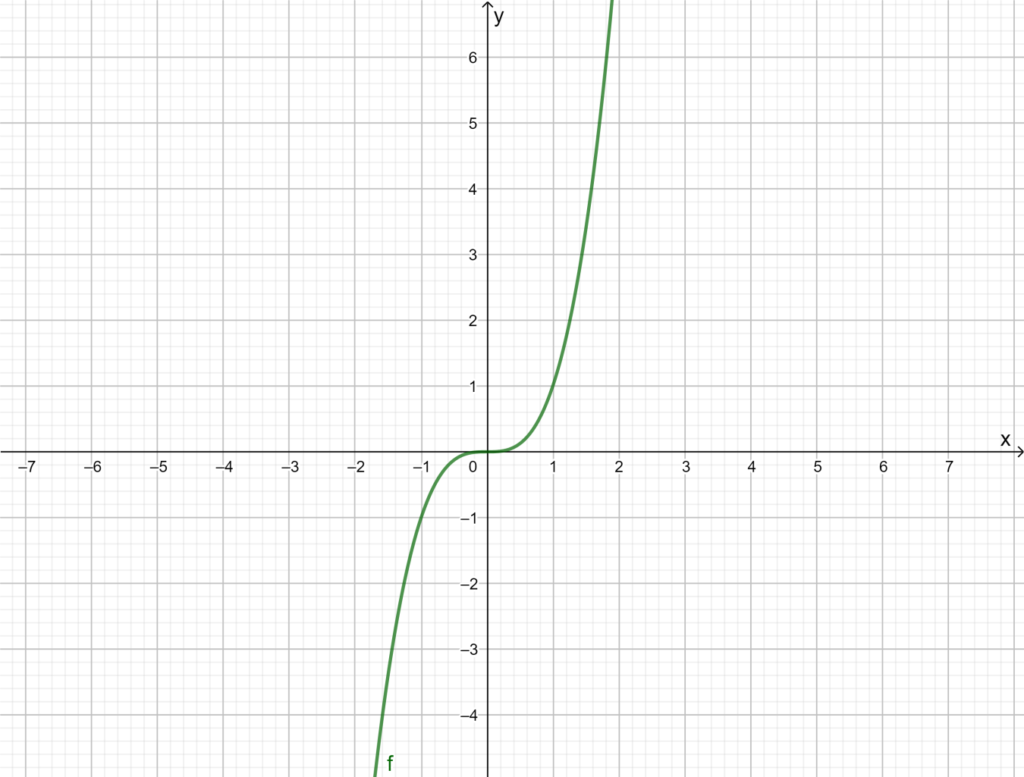
For a function to be symmetrical about the origin ,replace y with −y and x with −x and the resulting function must be equal to the original function.
There is no variable y in the given function, so substitute x as −x and check.
f(−x)=(−x)3
f(−x)=−x3
Now, make the graph off(−x)=−x3.
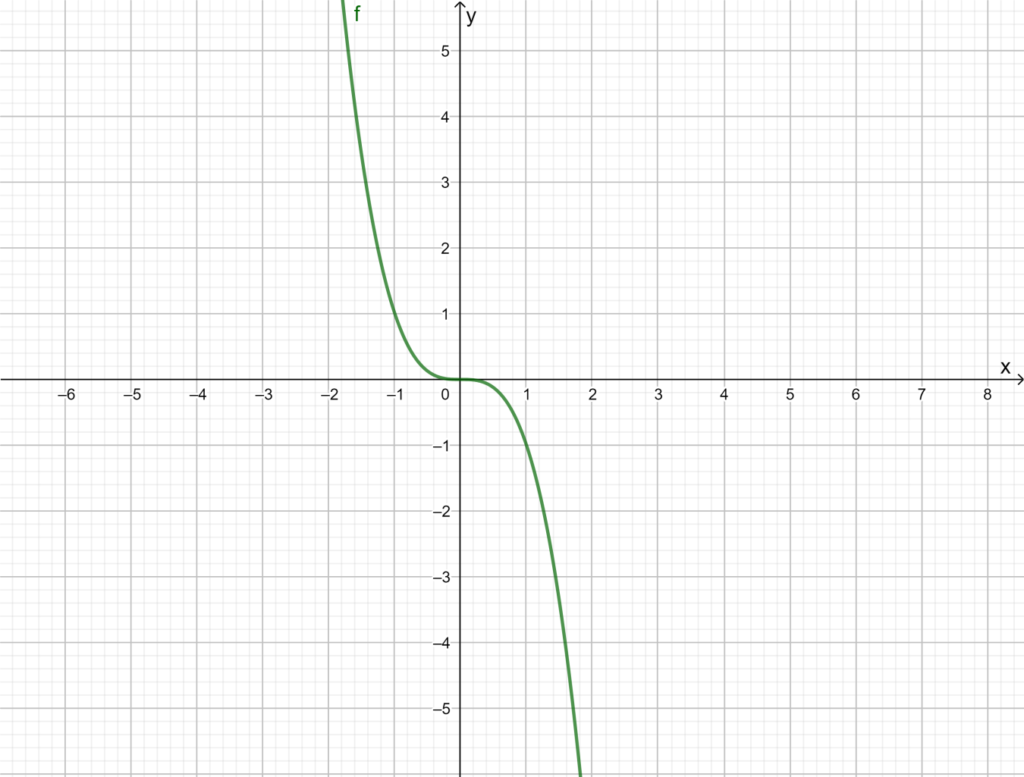
From the two graph it is clearly shows that the graph is symmetric about the origin as every point (x,y) on the graph, the point (−x,−y) is also on the graph.
Thus, the function f(x)=x3 is symmetry about the origin.
The function f(x)=x3 is symmetric about the origin as every point (x,y) on the graph, the point (−x,−y) is also on the graph.
Page 236 Problem 14 Answer
It is given that the graph of the function, $g(x)=(−x)3 is a reflection of the graph of f(x)=x3across the y-axis while the graph of h(x)=−x3 is the reflection of f(x) across the x-axis.
It is required to explain the similarity or differences between the graph of h(x) and g(x) when graphed using a graphing calculator.
First, plot f(x), g(x), and h(x) using the graphing calculator. Further, notice any similarities or differences in the graph of the function.
Plot the function,f(x),g(x), and h(x).
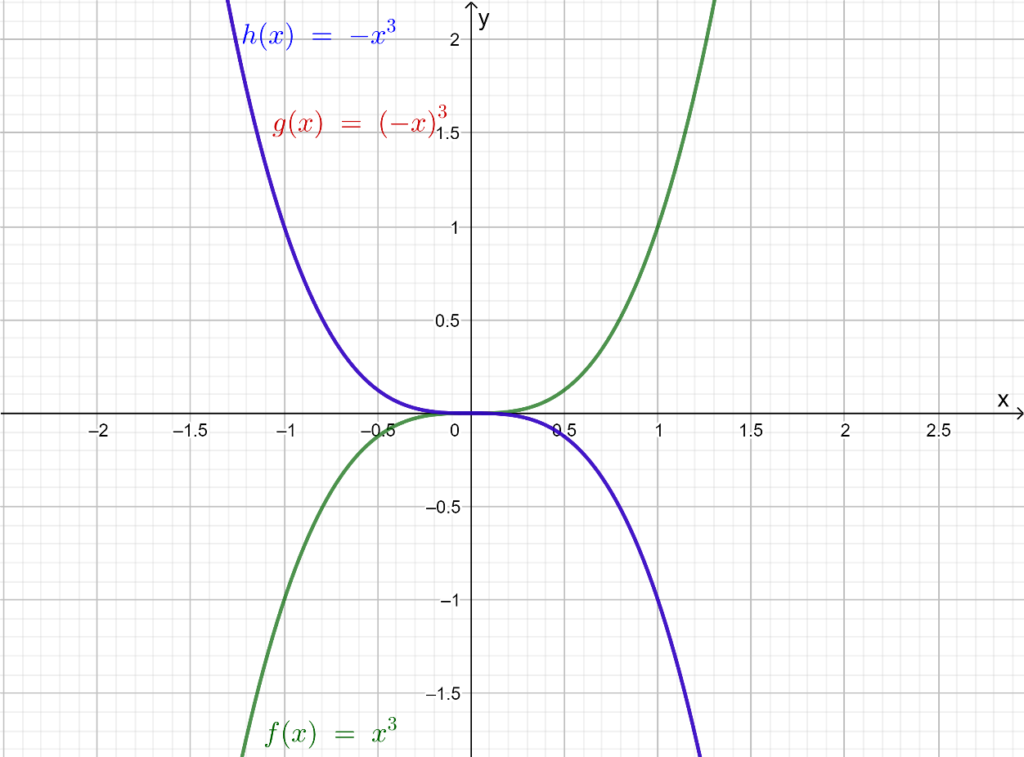
From the graph it is observed that g(x), and h(x) are equivalent function. Therefore, both have the same graph.
The graph of the function g(x)=(−x)3and h(x)=−x3 is equivalent.
Page 238 Problem 15 Answer
It is given a function, g(x)=−12(x−3)3. the graph of g(x) is produced by transforming the graph of g(x).
It is required to identify the transformation used and graph the function on the same coordinate plane of f(x) using the reference points, (−1,−1), (0,0), and(1,1)
Take a reflection of given graph f(x)=x3 further compress graph by factor 0.5 vertically and translate by factor 3 to the right.
Now, make a table with x and y coordinates of function g(x)=−12(x−3)3, and plot the graph with help of coordinates accordingly.
The transformation used to get the graph of g(x) from f(x) is the reflection of f(x) along y-axis followed by a dilation of scale factor 12, further followed by a translation of 3 units to the right.
The final coordinates will be as follows.
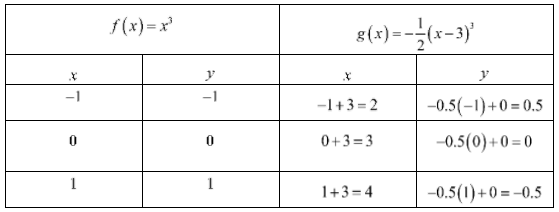
The ordered pairs are (2,0.5),(3,0), and (4,−0.5).
Plot the ordered pairs obtained and get the graph of g(x).
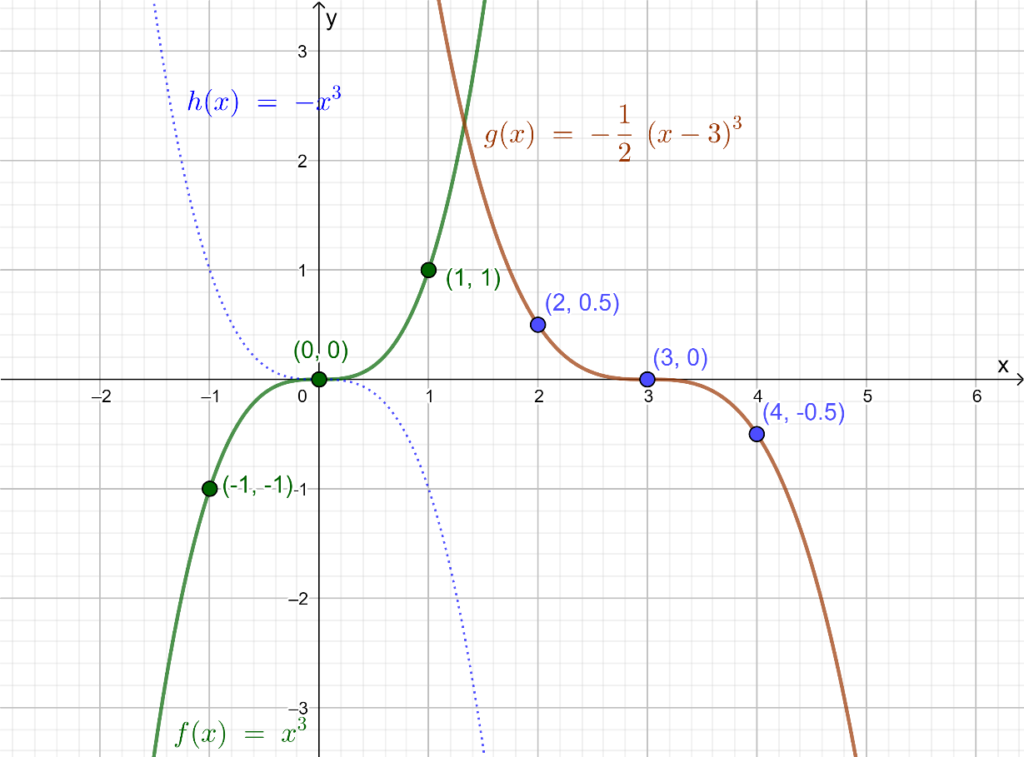
The graph of the function g(x) is as follows:
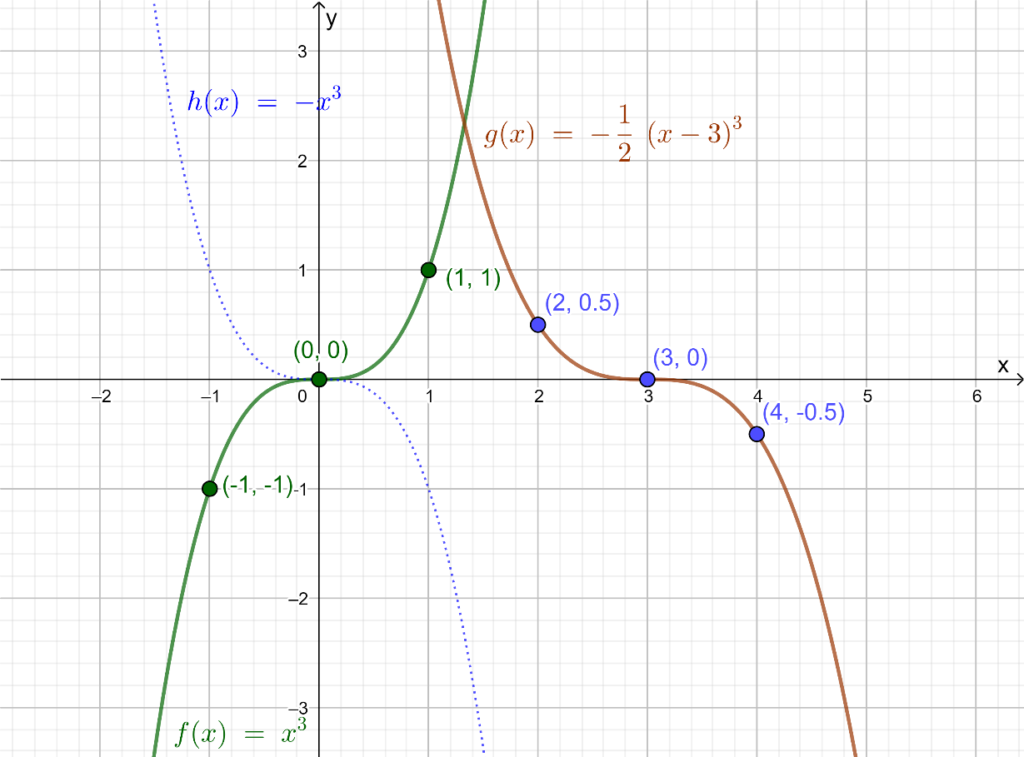
How To Solve Polynomial Functions Exercise 5.1 HMH Algebra 2
HMH Algebra 2 Volume 1 1st Edition Module 5 Chapter 5 Exercise 5.1 Polynomial Functions Page 239 Problem 16 Answer
The general equation for cubic function, g(x)=(1b(x−h))3+k is given along with the function’s graph.
It is to write a specific equation by identifying the values of the parameters from the reference point as shown in the graph.
Identify the values of h and k using the graph. Then, find the value of the constant a.
Thus, substitute the value in the equation and get the required answer.
Identify the values of h and k from the point of symmetry. Here, (h,k)=(1,−1).
Therefore, h=1, and k=−1. Identify the values of a. The right most point has general coordinates (h+b,1+k).
Substituting 1 for h, and -1 for k.
(h+b,1+k)=(1+b,0)
(1+b,0)=(5,0)
Equate 1+b with 5. Subtract 1 from both sides to solve for b.
1+b=5
b=5−1
b=4
Therefore, b=4.
Find the equation of the function.
Substitute b as 4, h as 1, and k as −1 in the equation g(x)=a(x−h)3+k.g(x)=(1/4(x−1))3−1
Therefore, the required function is g(x)=(1/4(x−1))3−1.
The required function is g(x)=(1/4(x−1))3−1.
Page 234 Problem 17 Answer
It is required to discuss why it is important to plot multiple points on the graph of the volume function.Mass and volume are related through density.
Volume function graphs can be expressed as graph changing mass and dimension of object keeping density constant.Hence, volume function graphs can be represented by cubic function.
The value of function keeps on changing at every dimension.Now, as the graph keeps on changing at all dimensions, multiple points are plotted to ensure accuracy of the graph.
The volume function is a cubic function. Multiple points are plotted to ensure the accuracy of the graph.
Page 242 Problem 18 Answer
It is given a function, f(x)=x3. It is to identify which transformation (stretch or compressions, reflection, and translation) change the attributes of the function.
The end behaviour of a graph is defined as what is going on at the ends of each graph, as the function approaches positive or negative infinitely, the leading term determines what the graph looks like as it moves towards infinity.
Therefore, all the transformation changes the attributes of the function.Transformation that changes end behavior are reflection, translation and stretch or compressions.
Transformation that changes end behavior are reflection, translation and stretch or compressions
Module 5 Chapter 5 Polynomial Functions Problems HMH.
HMH Algebra 2 Volume 1 1st Edition Module 5 Chapter 5 Exercise 5.1 Polynomial Functions Page 242 Problem 19 Answer
It is given a function, f(x)=x3. It is to identify which transformation (stretch or compressions, reflection, and translation) change the attributes of the function.
The location of the point of symmetry define position of point of symmetry. Transformation that changes location of the point of symmetry is translation.
The location of point of symmetry are transformed by translation.
Page 242 Problem 20 Answer
It is given a graph of f(x)=x3.
It is to identify which transformation (stretch or compressions, reflection, and translation) changes the attributes of the function.
Symmetry about a point defines the point at the same distance from the central point.
The transformations often preserve the original shape of the function.
Common types of transformations include rotations, translations, reflections, and scaling.
Assume two functions, f(x)=x3and g(x)=x3+5 which is the translation of the graph of f by 5 units upwards.
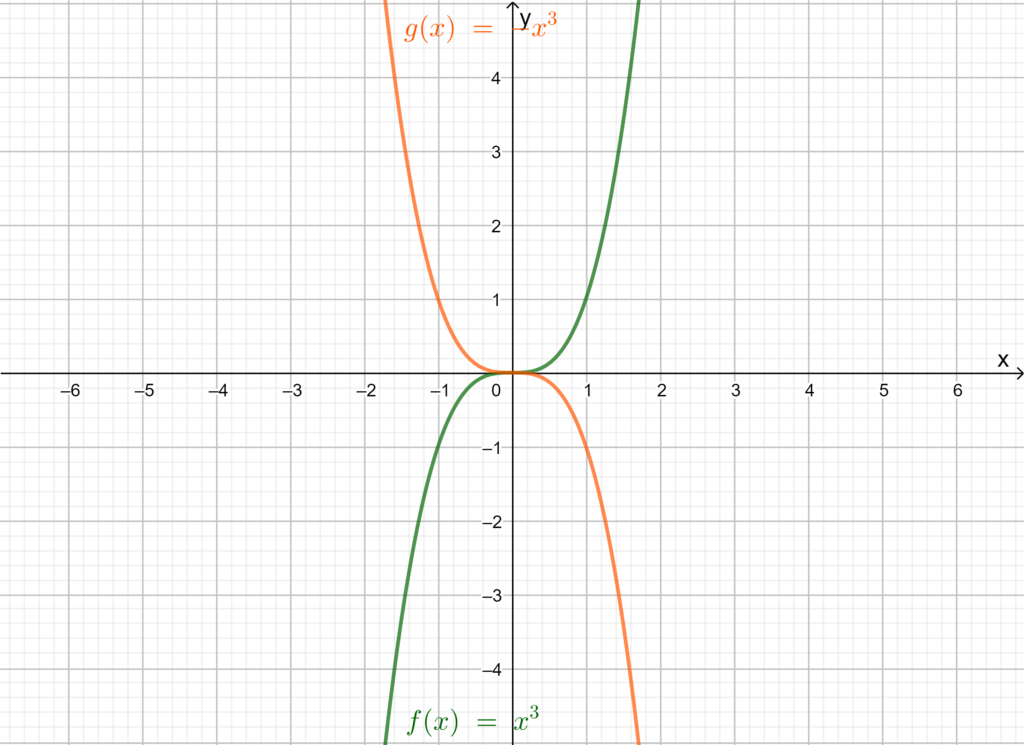
Now, it is evident from the graph that both graphs do not have symmetry. Therefore, this implies that when translation is done the function changes its symmetry.Similarly, consider two functions, f(x)=x3 and h(x)=−x3.
Observe the graph of these functions.
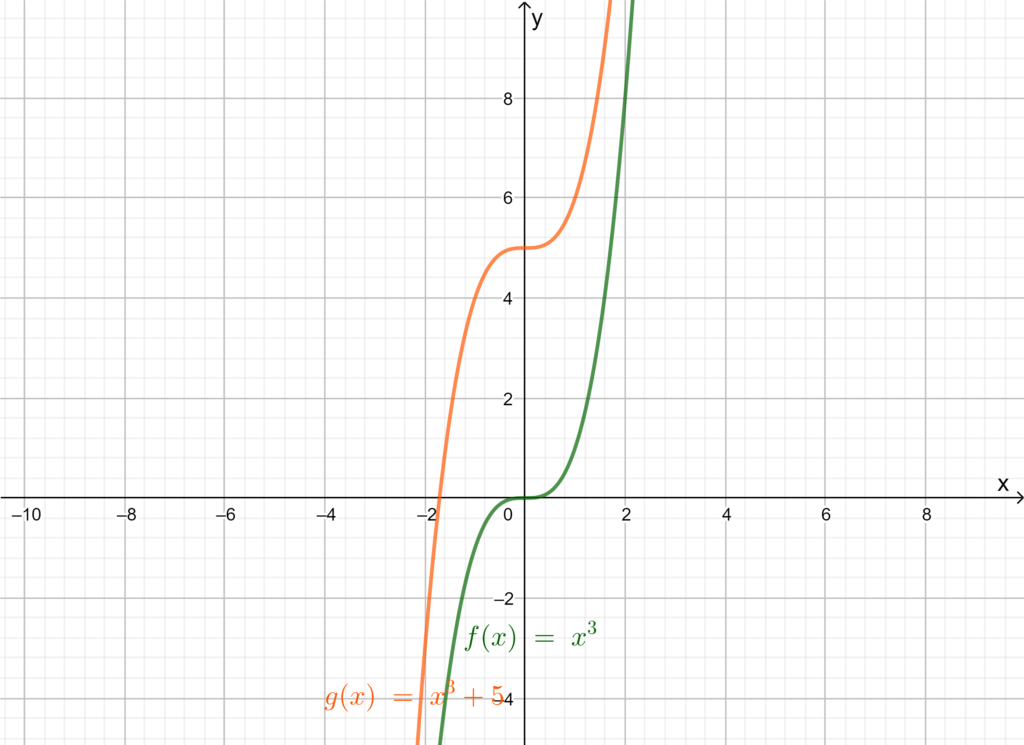
This is a special case where reflection is over the y axis, preserves the symmetry.Hence, the transformations that contribute in changing the symmetry about a point are reflection and translation.
The transformation that changes symmetry about a point is reflection and stretch or compressions.
Page 242 Problem 21 Answer
It is given graph f(x)=x3and g(x)=a(x−h)3+k.
It is to describe transformation on f(x) to obtain g(x).
Following transformation are made on f(x) that gives graph g(x).
First, a vertical stretch by a factor a unit, then translation of h unit to right and k unit to down.
Note that the translation of h unit to right affect only x coordinate whereas, vertical stretch by the factor a unit and translation of k unit to down affect only y coordinate of the point on the graph.
Therefore, the transformation is vertical stretch of the graph of f(x) by a units, followed by a translation of h units right, and k units down.
The transformation to transform f(x) to get the graph of g(x)=a (x−h)3+k is a vertical stretch of the graph of f(x) by a units, followed by a translation of h units right, and k units downwards.
Explain
Page 236 Exercise 1 Answer
It is given that g(x)=(2(x+3))3+4 and f(x)=x3.
It is required to identify the transformation of the graph f(x)=x3 by applying the transformation using the reference points and draw the graph of given g(x) on the same coordinate plane. It is also required to complete the table.
First, identify the transformation of the graphf(x)=x3. that produce the graph of the given function g(x) , then the graph g(x)on the same coordinate plane as the graph of f(x) by applying the transformation to the reference points (−1,−1),(0,0)and (1,1).
The graph of the transformation of f(x)=x3 , helps to consider the effect of the transformation on the three reference points on the graph of f(x):(−1,−1),(0,0) and (1,1) .
The table lists the three points and the corresponding points on the graph of g(x)=a(1/b(x−h))+k.
Notice that the point (0,0), which is the point of symmetry for the graph of f(x), is affected only by the parameters h and k .
The other two reference points are affected by all four parameters.

Compare the given functiong(x)=(2(x+3))3+4 with the equation, g(x)=a(1/b(x−h))3+k.
Therefore, the value of k is 4, a is 1, b is 1/2, and his−3 .
now, fill the table according to these values.
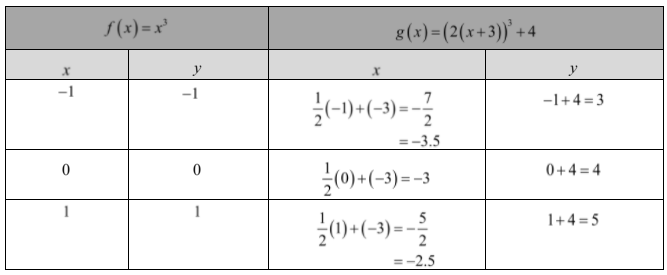
The graph of the given function g(x)=(2(x+3))3+4 on the same coordinate plane of f(x)=x3 by applying the transformation to the reference points (−1,−1),(0,0)and (1,1) is given below.
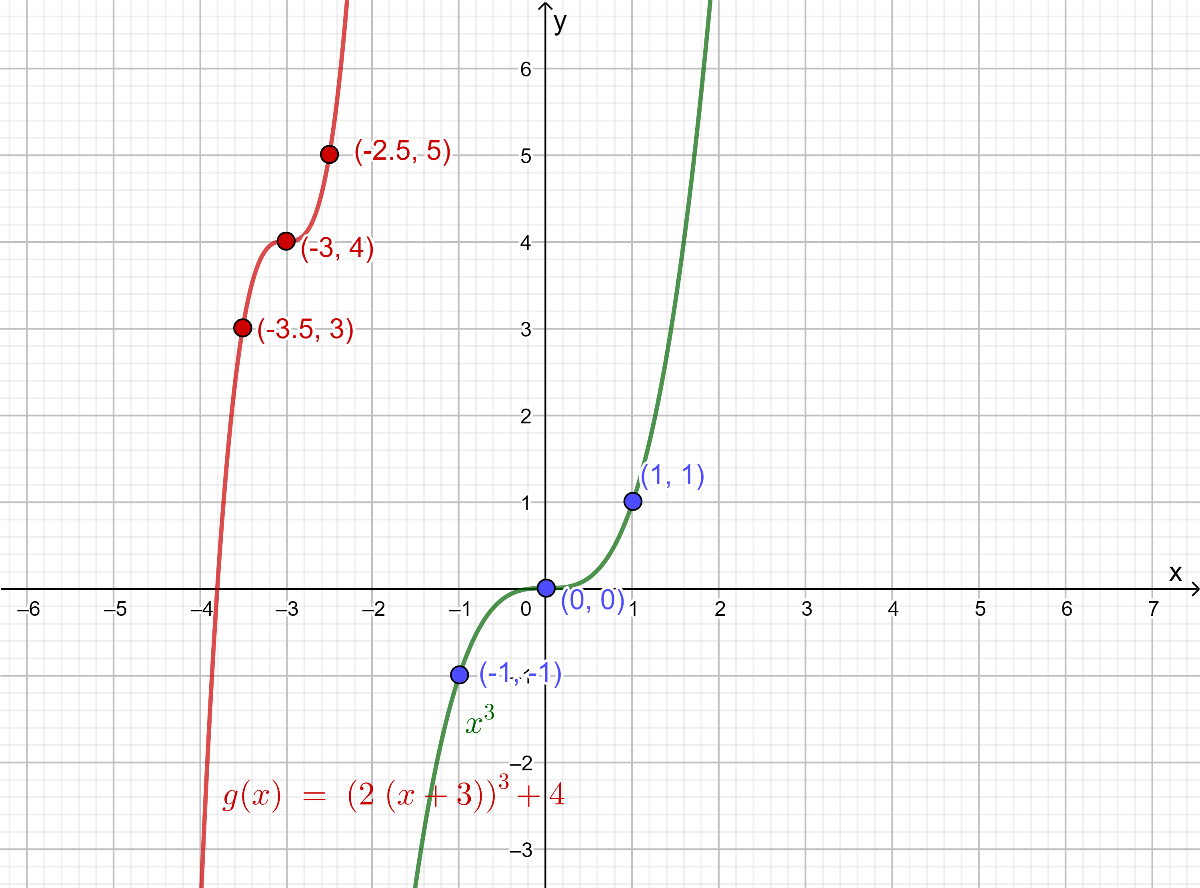
The graph of the given function g(x)=(2(x+3))3+4 on the same coordinate plane as the graph off(x)=x3is shown below.
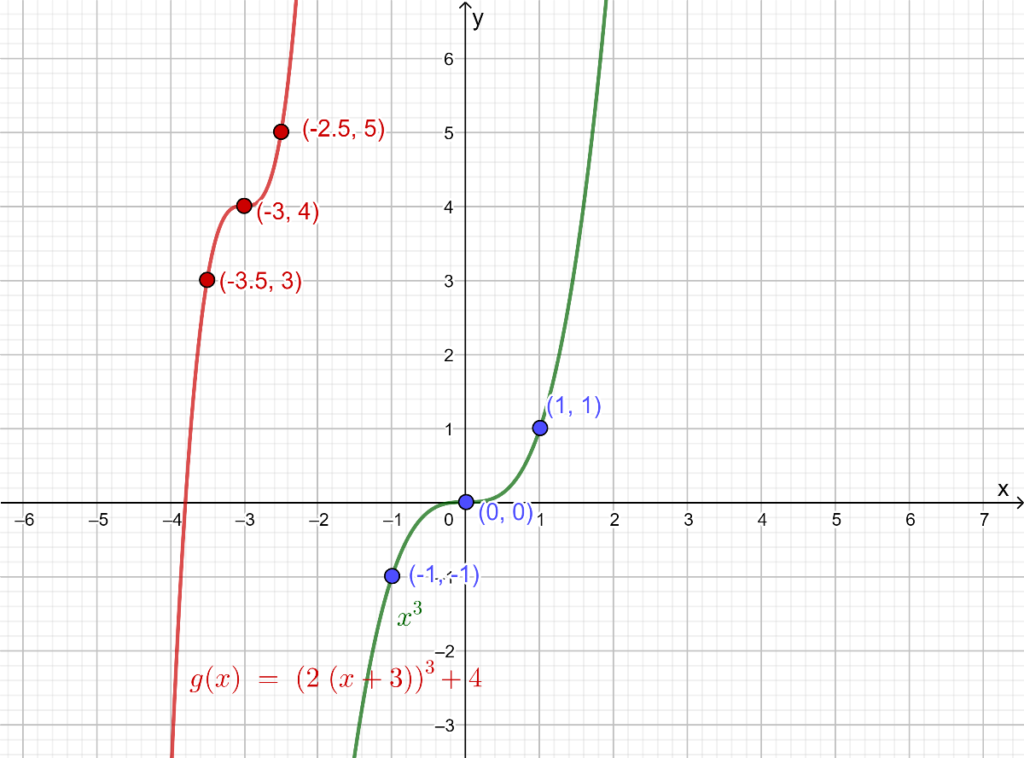
The complete table is given below.

Page 240 Exercise 2 Answer
It is given a steel ball bearing with a mass of 75 grams and a density of 7.82g/cm3.
It is required to estimate the radius of the steel ball.
To find the required answer graph the function using the calculated values then use the graph to obtain the indicated estimate.
Let r represent the radius of the ball bearing.
The volume V of the bell bearing is V(r)=mr3.
The mass in the ball bearing is m(r)=7.82.
Then ,V(r)=7.82r3.
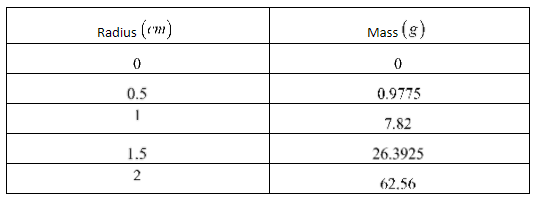
Draw the Graph of the function, V(r)=mr3.

Recognize that the graph is vertical compression of the graph of the parent cubic function by a factor of 7.82.
Then draw the horizontal linem=75 and estimate the value of r where the graph intersect.
The graph intersect where r≈2.1, so the radius of the steel ball bearing is about 2.1cm.
The estimated radius of the steel ball bearing is about 2.1cm with a mass of 75 grams and a density of 7.82g/cm3.
HMH Algebra 2 Chapter 5 Polynomial Functions Step-By-Step Solutions
HMH Algebra 2 Volume 1 1st Edition Module 5 Chapter 5 Exercise 5.1 Polynomial Functions Page 243 Exercise 3, Answer
It is given a cubic function of f(x)=x3
It is required to graph the function and state the function’s domain and range
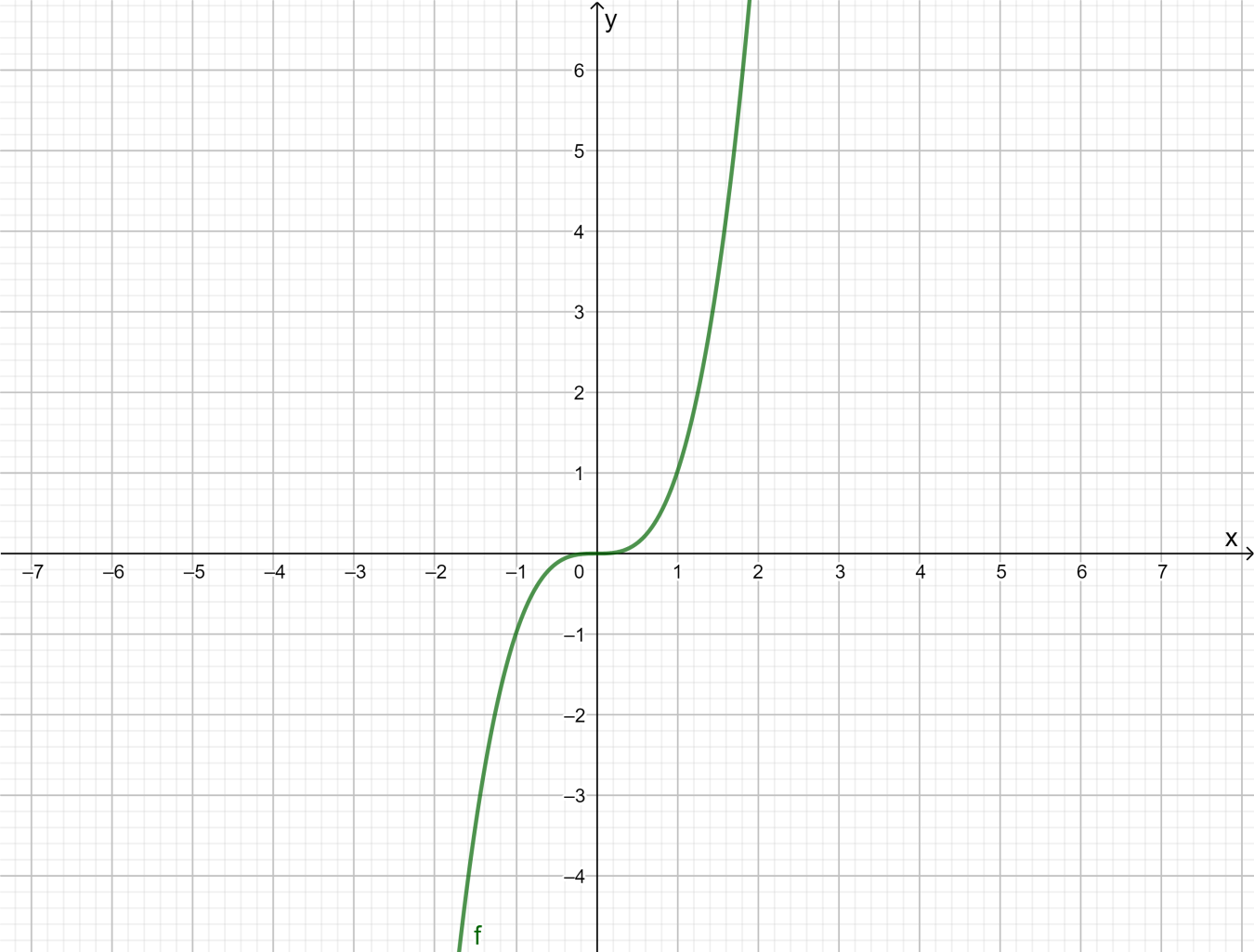
Observe that f(x)=x3 is can take all values lying between −∞ to ∞ Thus, the domain will be (−∞,∞)
When the function takes all values of its domain it gives values lying between −∞ to ∞
Thus, the range will be (−∞,∞)
Therefore, the domain and range of the function is (−∞,∞)
The domain and range of f(x)=x3 is(−∞,∞)
Page 243 Exercise 4, Answer
It is given a function f(x)=x3
It is required to draw the graph of the function and identify the functions end behaviour
First graph the function by finding the ordered pairs by substituting the values of xas −2, −1, 0, 1, 2.
Then, plot the ordered pairs and join them through a curve to get a graph Then, observe the end behaviour of the function
Find the ordered pairs to plot the graphSubstitute the value of x as −2, −1, 0, 1, 2 simultaneously in y=x3

The ordered pairs will be points (−2,−8),(−1,−1),(0,0) (1,1) and (2,8)
Plot the order pairs
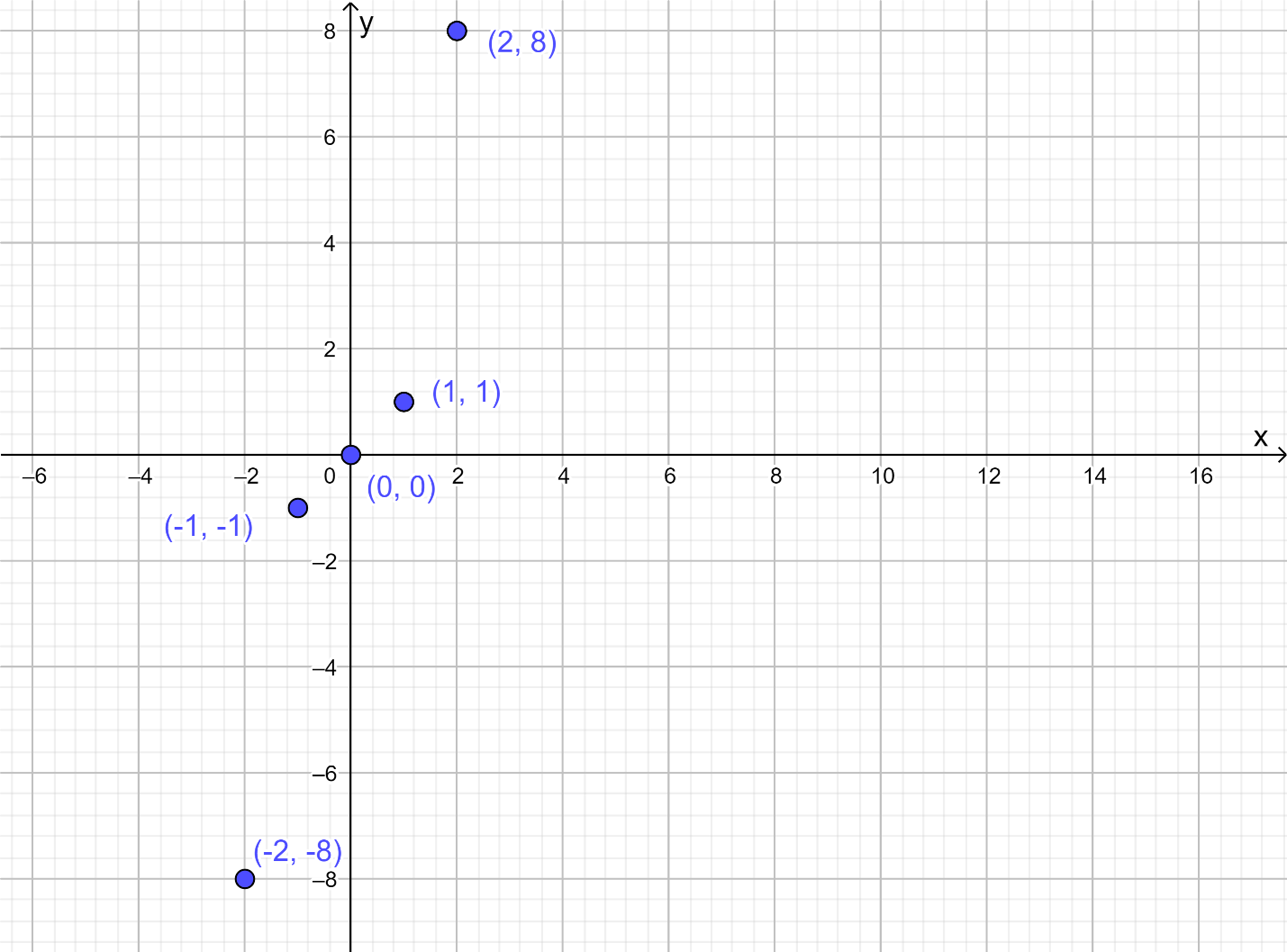
Draw a smooth curve on the obtained pair through the plotted points to obtain the graph f(x)=x3
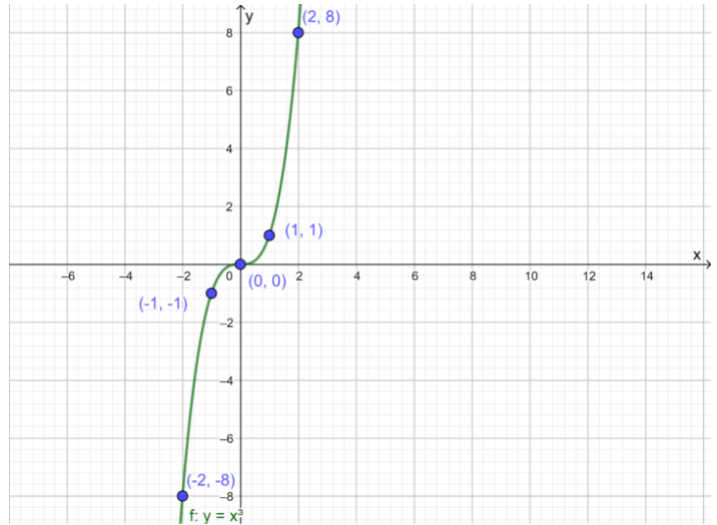
From the graph it is clear that whenx→+∞, the function approaches its positive values Therefore, whenx→+∞, f(x)→+∞ Also, when x>0then, f(x)>0
Similarly, when x→−∞, the function approaches its negative values Therefore, when x→−∞then, f(x)→−∞
The end behaviour of the function is when x→+∞, f(x)→+∞and x→−∞,f(x)→−∞
Page 243 Exercise 5, Answer
It is given the cubic function f(x)=x3
It is required to identify the graph’s x-intercept and y-interceptThe graph of f(x)=x3 inferred from part (b) is as follows

From the graph it is observed that the graph intersects at x-axis is (0,0) and the point where a line crosses the y-axis is also (0,0)
Therefore, x-intercept and the y-intercept is 0
The x-intercept and the y-intercept of the function f(x)=x3 is zero
HMH Algebra 2 Volume 1 1st Edition Module 5 Chapter 5 Exercise 5.1 Polynomial Functions Page 243 Exercise 6, Answer
It is given a cubic function f(x)=x3
It is required to graph the functionf(x)=x3 and identify the intervals where the functions has positive values and where it has negative values
The graph of f(x)=x3 inferred from part (b) is as follow

From the graph, it is observed that for the values of x greater than zero, the function has positive values and for the values of x less than zero, the function has negative values
Thus, the function has the positive values at the interval of (0,+∞) and the negative values at the interval of (−∞,0)
The function f(x)=x3 has the positive values at the interval of (0,+∞) and negative values at the interval of (−∞,0)
Page 243 Exercise 7, Answer
It is given a cubic function f(x)=x3
It is required to identify the intervals where the function is increasing and where it decreasing by using the drawn graph of f(x)=x3
The graph of f(x)=x3 inferred from part (b) is as follows
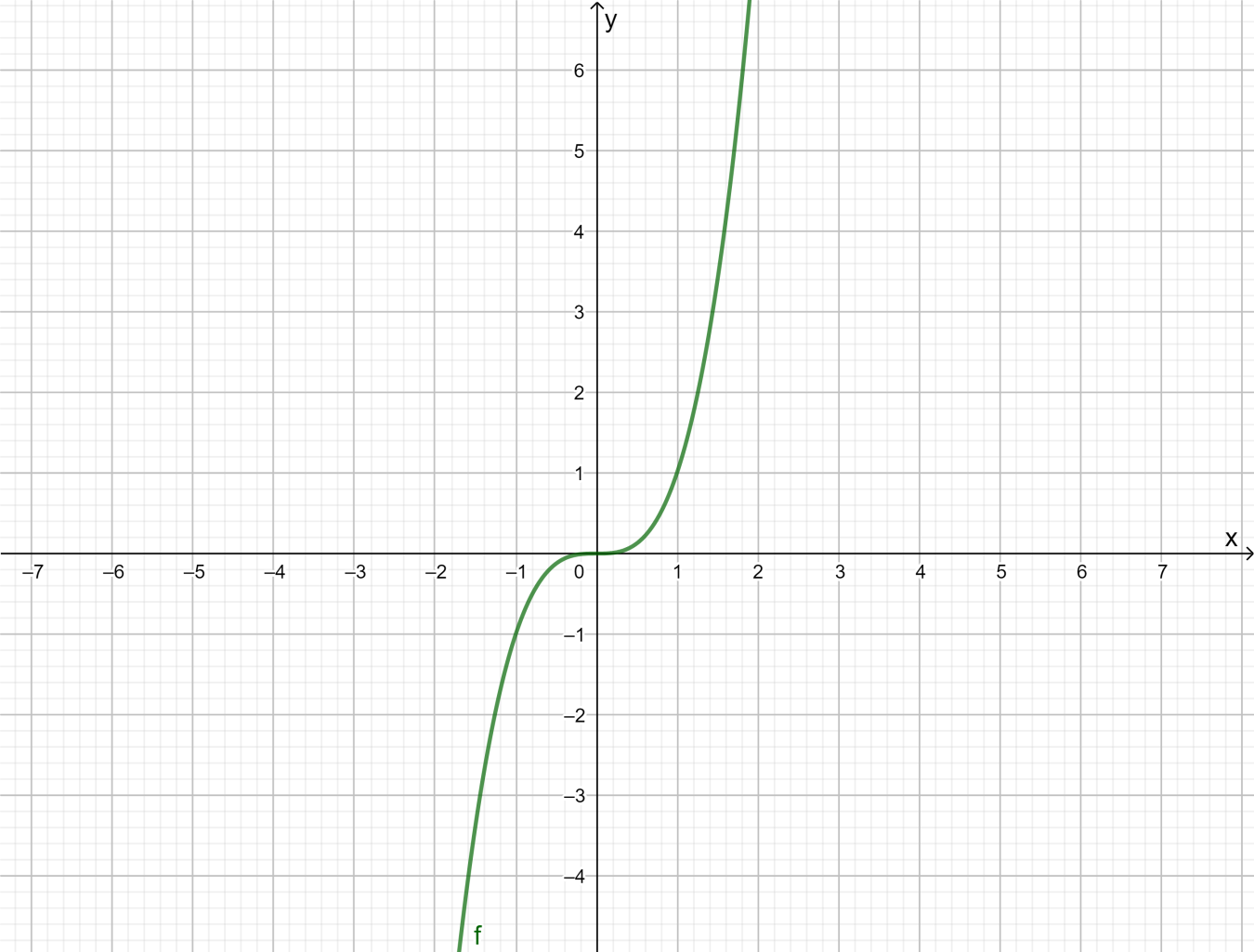
From the graph it is observed that y=f(x)is increasing when value of x increasing but the value is never decreasing irrespective of x
Thus, the function f(x)=x3 is increasing when x>0 but it never decreasing
The function f(x)=x3 is increasing when x>0and decreasing at ϕ
Page 243 Exercise 8, Answer
It is given a cubic function f(x)=x3
It is required to explain whether the function is even ,odd or neither The graph of f(x)=x3 inferred from part (b) is as follows
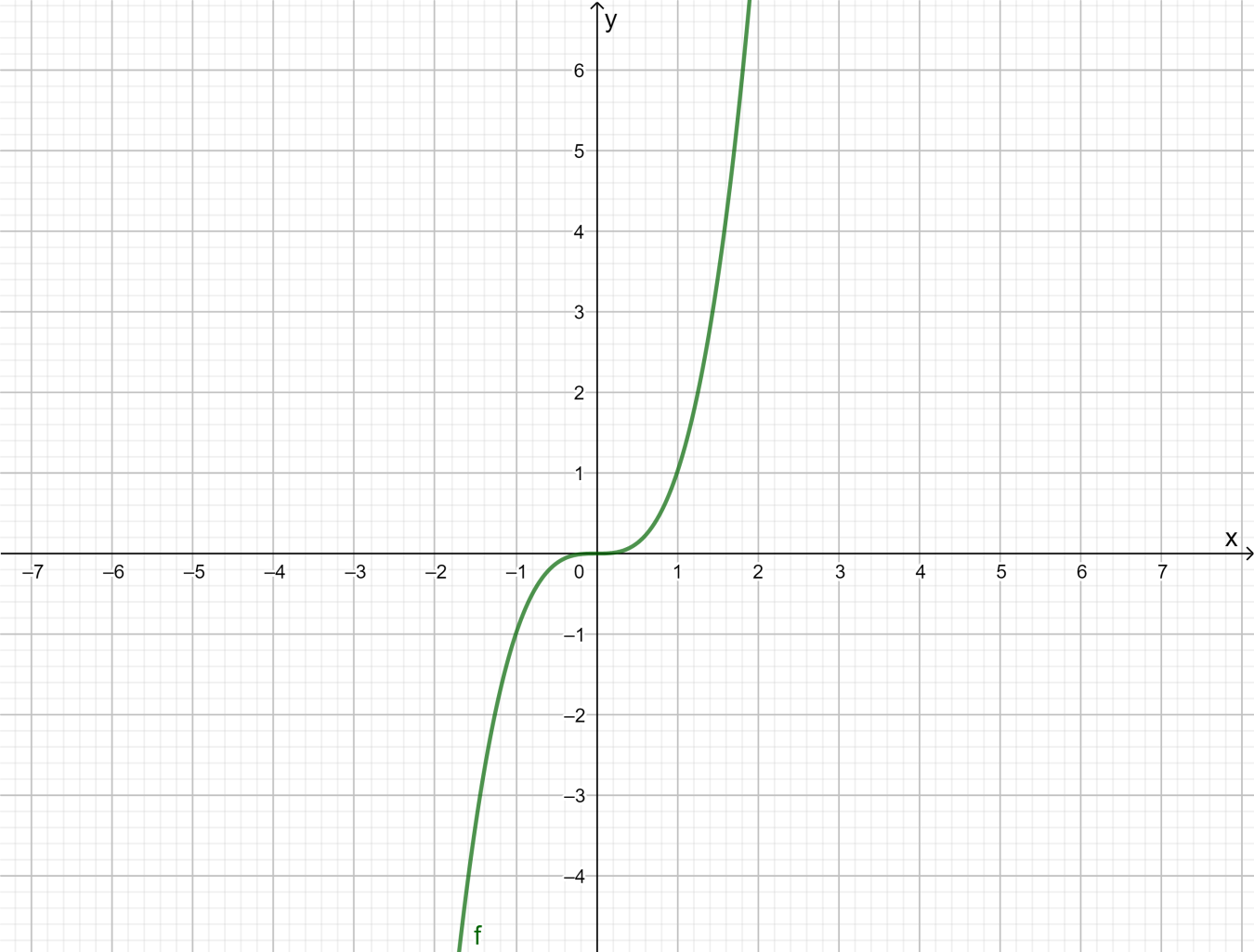
The function is symmetric about the line y=x,so the function is an odd functionTherefore, the function f(x)=x3 is an odd function
The function f(x)=x3 is an odd function as it is symmetric about the line y=x
HMH Algebra 2 Volume 1 1st Edition Module 5 Chapter 5 Exercise 5.1 Polynomial Functions Page 243 Exercise 9, Answer
It is given a cubic function f(x)=x3
It is required to explain about symmetry of the given functionIt is inferred from the part (f) that the function is oddThe graph off(x)=x3 inferred from part (b) is as follows

From the graph it is clearly shows that the graph is symmetric about the origin as it is an odd function and an odd function is always symmetric about origin
Thus, the function f(x)=x3 is symmetric about origin
The function f(x)=x3 is symmetric about the origin as it is an odd function

Page 243 Exercise 10, Answer
It is given graph that g(x)=(x−4)3
It is to describe how the graph of g(x) is related to the graph of f(x)=x3
Draw graphs for each of the functions separately using a graphing calculator
Then, do the appropriate transformation to make both functions equal graphically which proves given functions are related
The parent function is f(x)=x3 Using graphing calculator, draw the graph of the function f(x)=x3
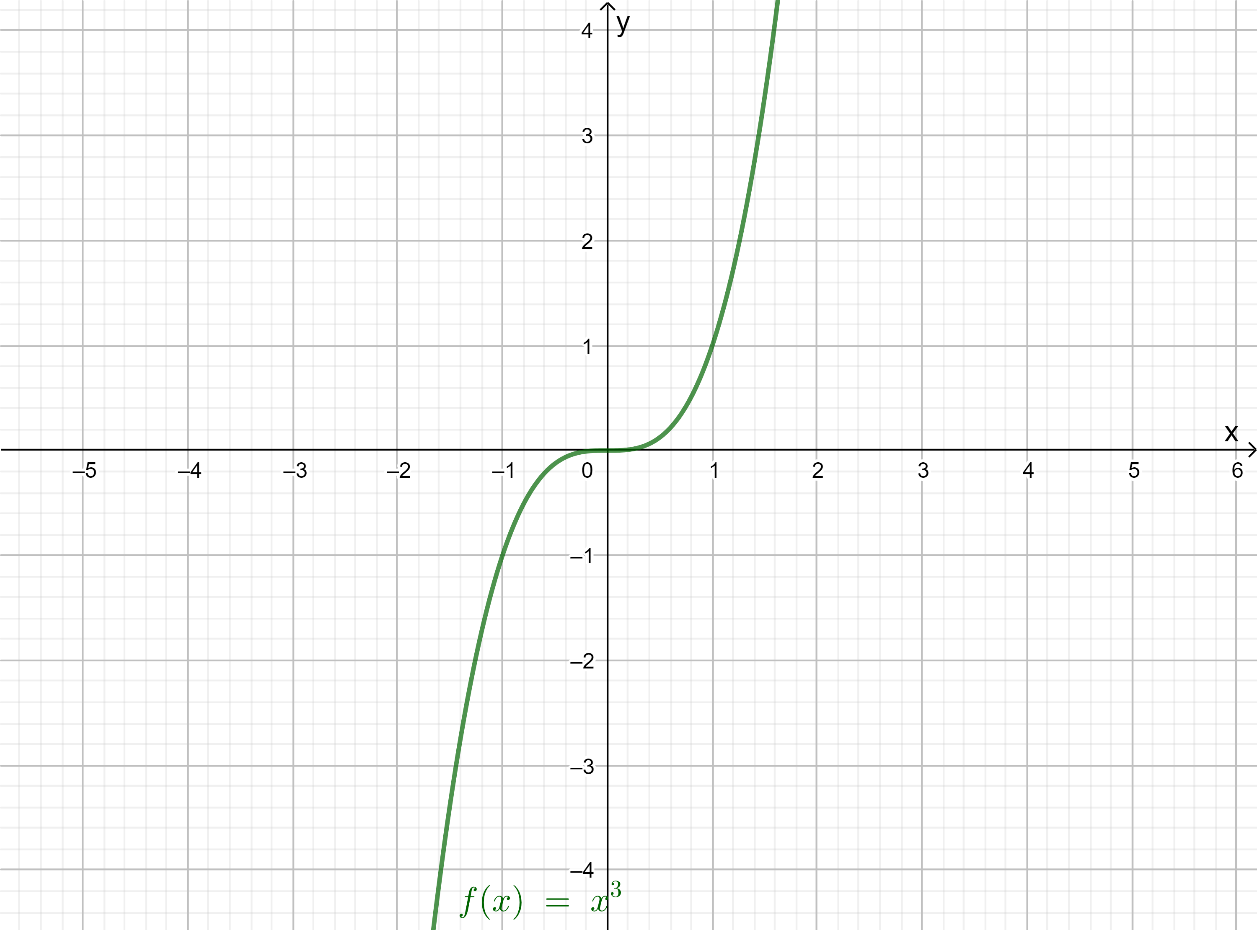
The function, g(x)=(x−4)3 is of the form g(x)=(x−a)
Then, consider the fact that if a is a positive number then, the graph of g(x)=(x−a) occurs from the horizontal translation of the graph of f, a units to the right Here, the value of a is 4
So, translate the graph of f(x)=x3four units to the right
The graph of g(x)=(x−4)3 will be as follows:
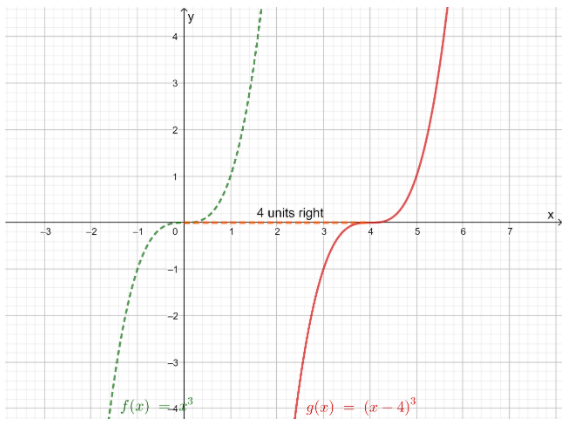
The graph of g(x)=(x−4)3 is the translation of the graph of f(x)=x3 to 4 units to the right
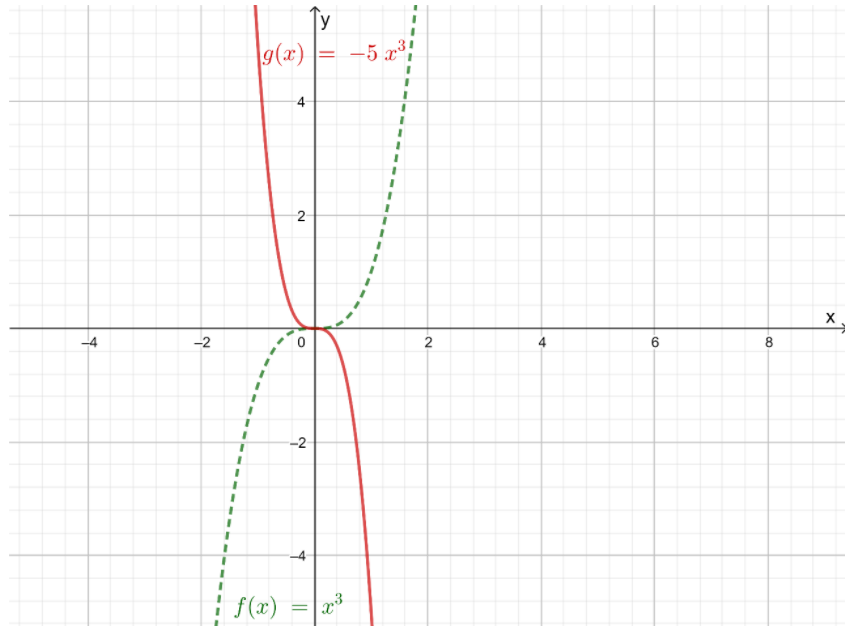
Solutions For Chapter 5 Exercise 5.1 Polynomial Functions HMH
HMH Algebra 2 Volume 1 1st Edition Module 5 Chapter 5 Exercise 5.1 Polynomial Functions Page 243 Exercise 11, Answer
It is given graph that g(x)=−5x3
It is to describe how the graph of g(x) is related to the graph of f(x)=x3
Draw graphs for each of the functions separately using a graphing calculator
Then, do the appropriate transformation using the rules to plot the graph of h(x)=a(1b(x−h))3+kand plot the required graph
The parent function is f(x)=x3Using a graphing calculator, draw the graph of the function f(x)=x3

The given cubic function is of the form h(x)=a(1b(x−h))3+k
For g(x), h=0,k=0, b=−1, and a=5
Thus, according to the rule of the cubic function h(x),the graph of g(x)=−5x3 is the reflection of f(x) in the y-axis followed by a vertical stretch of a factor of 5
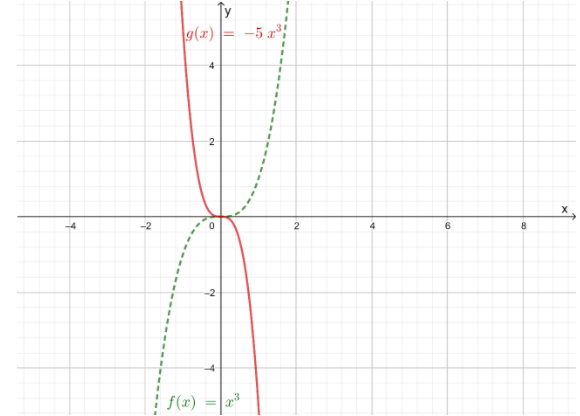
The graph of g(x)=−5x3 is the reflection off(x) in they-axis followed by a vertical stretch of a factor of 5
Page 243 Exercise 12, Answer
It is given that g(x)=x3+2
It is to describe how the graph of g(x)is related to the graph of f(x)=x3 Draw graphs for each of the functions separately using a graphing calculator
Then, do the appropriate transformation to make both functions equal graphically which proves given functions are related
The parent function is f(x)=x3
Using a graphing calculator, draw the graph of the function f(x)=x3
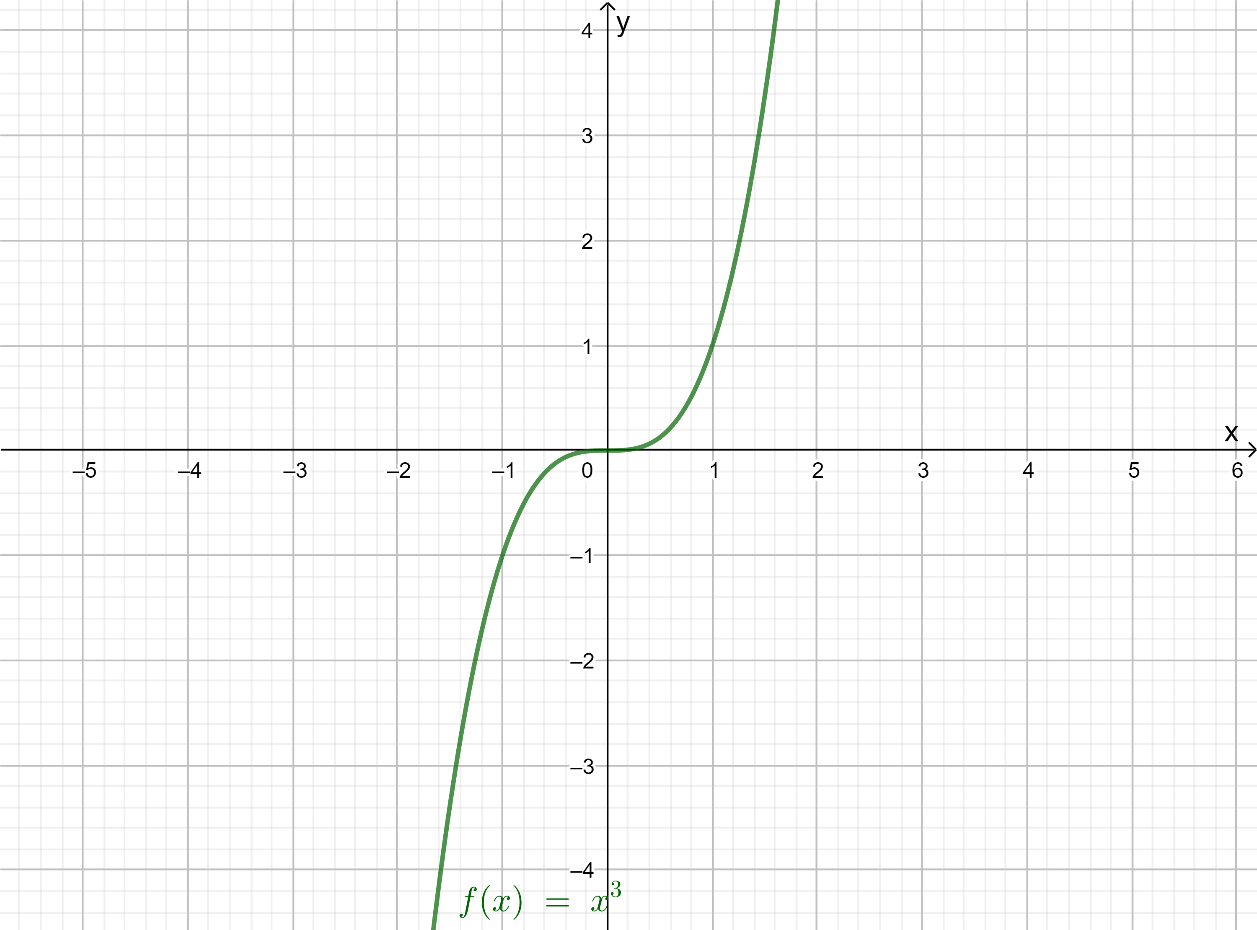
The function, g(x)=x3+2is of the form g(x)=f(x)+k
Then, consider the fact that if a is a positive number then, the graph of g(x)=f(x)+k occurs from the vertical translation of the graph of f, k units to the up Here, the value of k is 2
So, translate the graph of f(x)=x3 two units upwards
The graph of g(x)=(x−4)3 will be as follows:
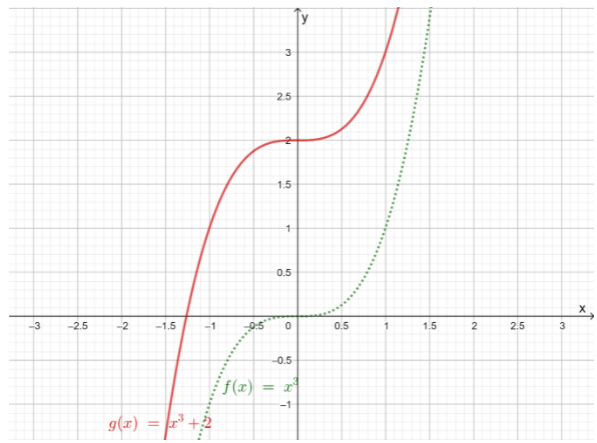
The graph of g(x)=x3 +2 is the translation of the graph of f(x)=x3 to 2 units upwards
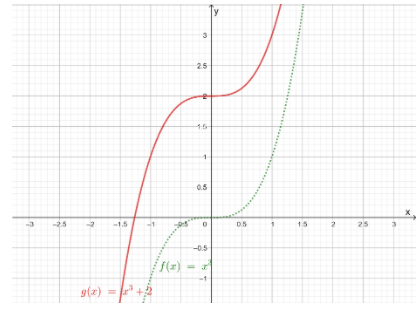
HMH Algebra 2 Volume 1 1st Edition Module 5 Chapter 5 Exercise 5.1 Polynomial Functions Page 243 Exercise 13, Answer
It is given graph that g(x)=(3x)3
It is to describe how the graph of g(x) is related to the graph of f(x)=x3
Draw graphs for each of the functions separately using a graphing calculator
Then, do the appropriate transformation using the rules to plot the graph of h(x)=a(1b(x−h))3+k and plot the required graph
The parent function is f(x)=x3
Using a graphing calculator, draw the graph of the function f(x)=x3
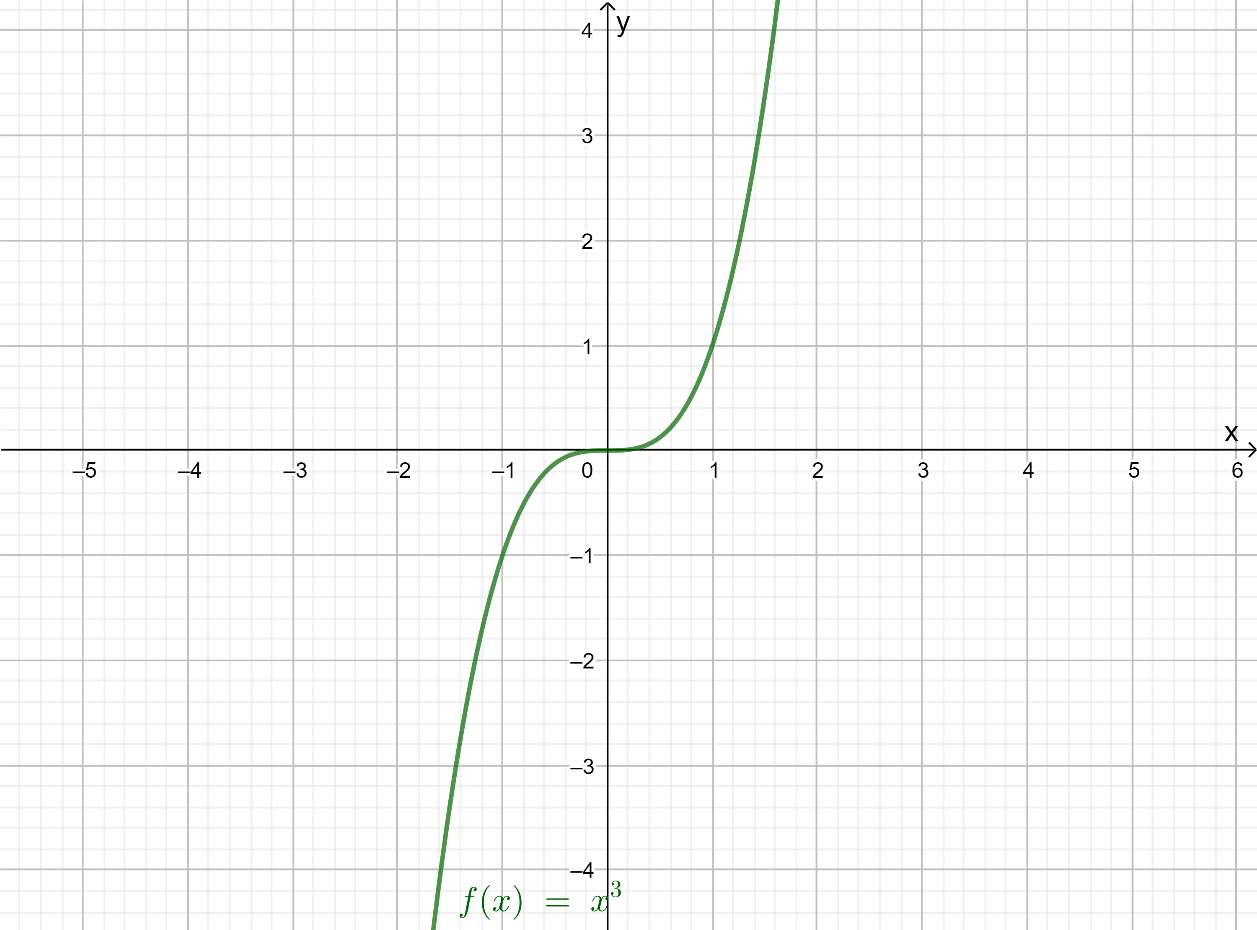
The given cubic function is of the form h(x)=a(1b(x−h))3+k
For g(x), h=0,k=0, b=13, and a=1
Thus, according to the rule of the cubic function h(x),the graph of g(x)=(3x)3is formed by compressing f(x)horizontally by a factor of 3
The graph will be as follows:
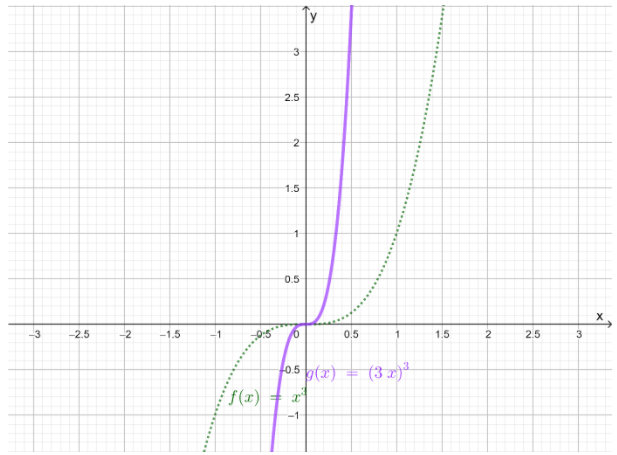
The graph of g(x)=(3x)3 is obtained by compressing f(x) horizontally by a factor of 3

Page 244 Exercise 14, Answer
It is given graph that g(x)=(x+1)3
It is to describe how the graph of g(x) is related to the graph of f(x)=x3
Draw graphs for each of the functions separately using a graphing calculator
Then, do the appropriate transformation to make both functions equal graphically which proves given functions are related
The parent function is f(x)=x3
Using graphing calculator, draw the graph of the function (x)=x3

The function g f(x)=(x+1)3 is of the form g(x)=f(x+a)
Then, consider the fact that ifa is a positive number then, the graph of g(x)=f(x+a) from the horizontal translation of the graph off, a units to the left Here, the value of a is 1
So, translate the graph of f(x)=x3 one unit to the left
The graph of g(x)=(x+1)3 will be as follows:
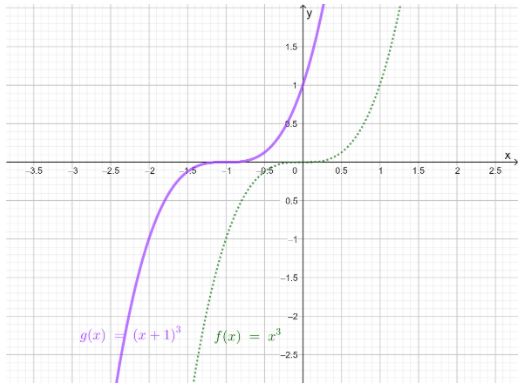
The graph of g(x)=(x+1)3 is the translation of the graph of f(x)=x3 to 1 unit to the left
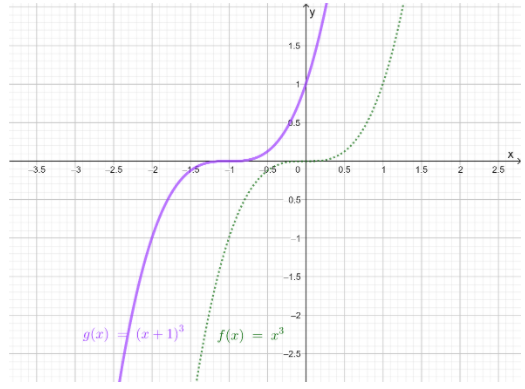
Page 244 Exercise 15, Answer
It is given that g(x)=x3−3
It is to describe how the graph of g(x) is related to the graph of f(x)=x3
Draw graphs for each of the functions separately using a graphing calculator
Then, do the appropriate transformation to make both functions equal graphically which proves given functions are related
The parent function is f(x)=x3 Using graphing calculator, draw the graph of the function f(x)=x3

The function, g(x)=x3 −3 is of the form g(x)=f(x)−k
Then, consider the fact that if a is a positive number then, the graph of g(x)=f(x)−k from the vertical translation of the graph of f, k units down Here, the value of k is 3So, translate the graph of f(x)=x3 three units down
The graph of g(x)=x3−3will be as follows:

The graph of g(x)=x3 −3 is the translation of the graph of f(x)=x3 to 3 units down
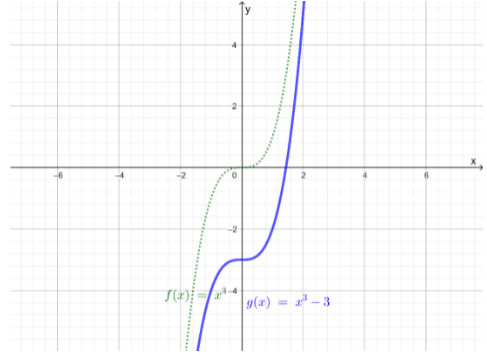
HMH Algebra 2 Volume 1 1st Edition Module 5 Chapter 5 Exercise 5.1 Polynomial Functions Page 244 Exercise 16, Answer
It is given graph that g(x)=(−23x)3
It is to describe how the graph of g(x)is related to the graph of f(x)=x3
Draw graphs for each of the functions separately using a graphing calculator
Then, do the appropriate transformation using the rules to plot the graph of h(x)=a(1b(x−h))3+kand plot the required graph
The parent function isf(x)=x3 Using a graphing calculator, draw the graph of the function f(x)=x3
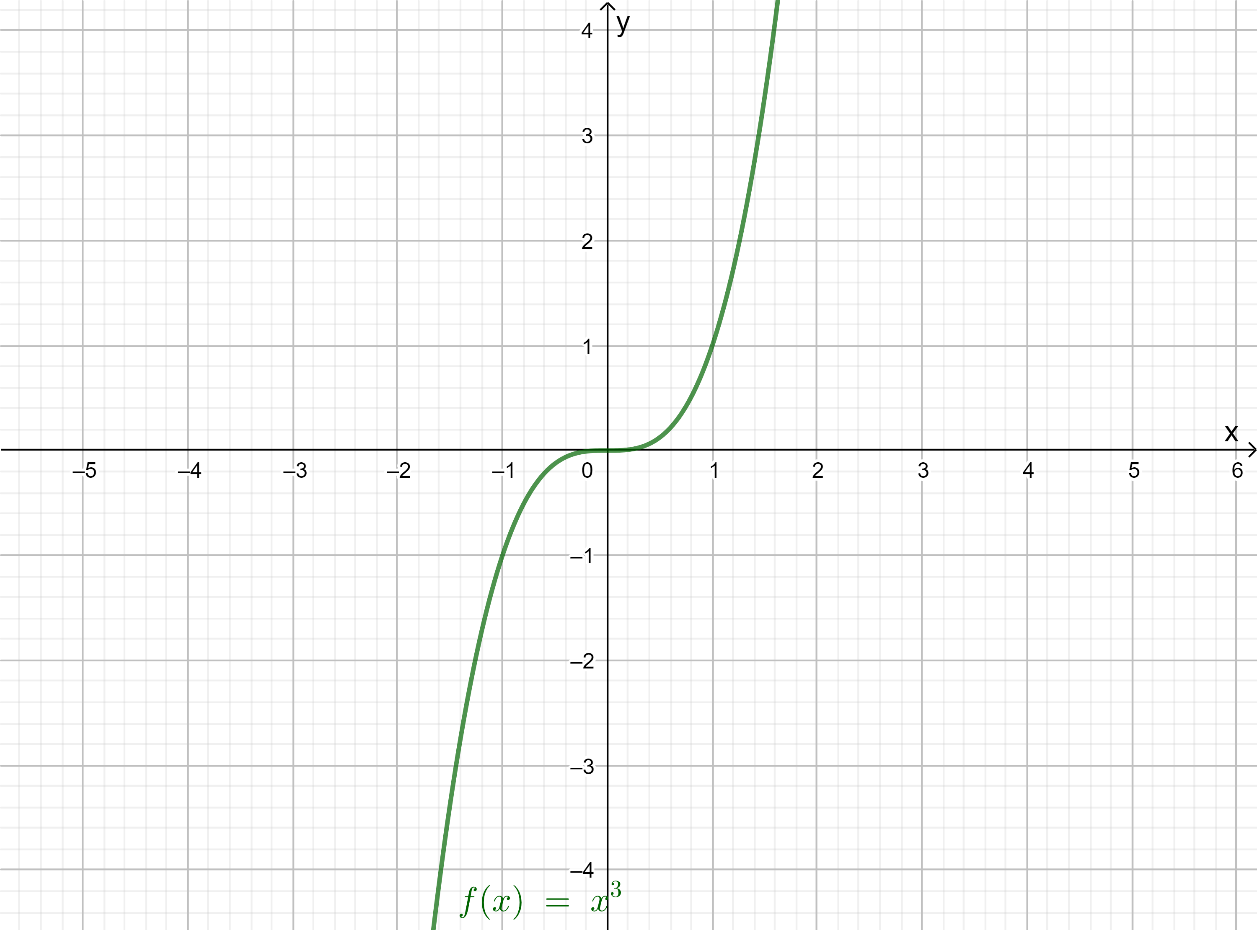
The given cubic function is of the form h(x)=a(1b(x−h))3+k
For g(x), h=0,k=0, b=32, and a=1
Thus, according to the rules of the cubic functionh(x),the graph of g(x)=(−23x)3is obtained by stretching f(x)horizontally by a factor of32, that is, 1.5
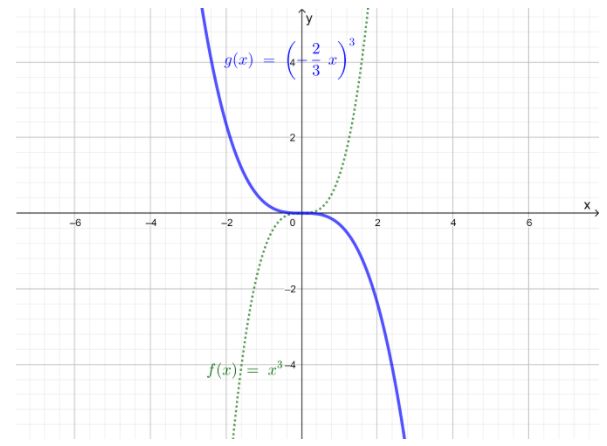
The horizontal stretching of f(x)by 15units gives the graph of g(x)=(−23x)3
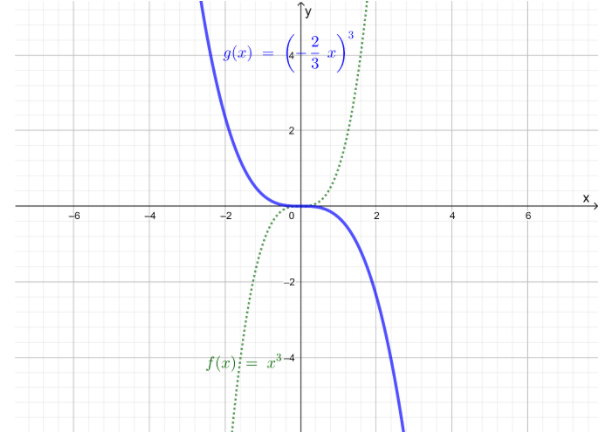
Page 244 Exercise 17, Answer
It is given that g(x)=(13x)3
It is required to identify the transformation that produces the graph of g(x)
when the parent function is f(x)=x3and then graph the function,g(x)using the reference points (−1,−1),(0,0), and(1,1)
Observe the type of g(x)then, Identify the transformation Now, make a table x and y coordinates of function g(x), and plot the graph with the help of coordinates obtained
The given cubic function is of the form h(x)=a(1b(x−h))3+k
For g(x), h=0,k=0, b=3, and a=1
Thus, according to the rules to make the graph of the cubic function h(x), transform the graph of f(x) by horizontally stretching it by a factor of 3
Now, find the coordinates to plot g(x)=(13x)3

Graph both the function on the same plane
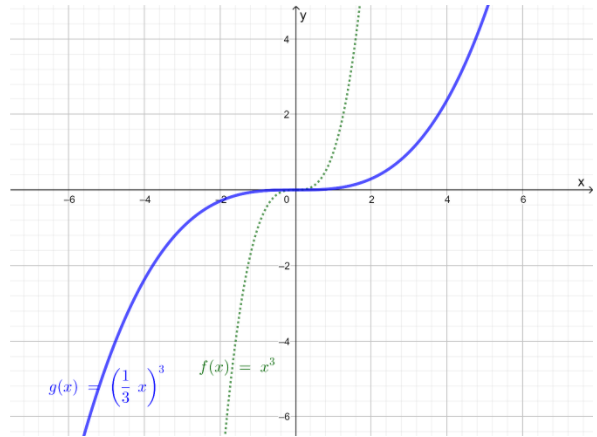
The transformation to graphg(x)=(13x)3using f(x)is horizontally stretchingf(x)by a factor of 3
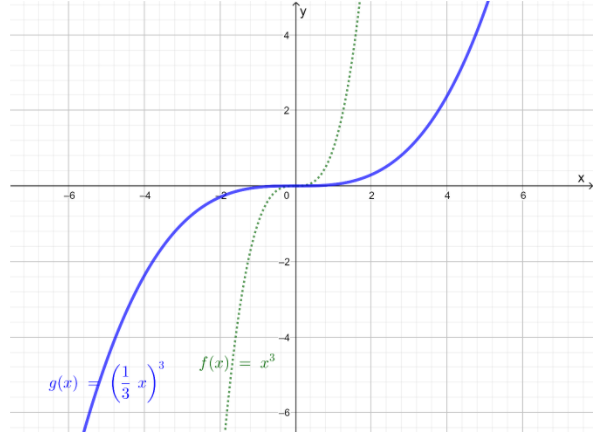
Exercise 5.1 Polynomial Functions Worked Examples HMH Algebra 2
HMH Algebra 2 Volume 1 1st Edition Module 5 Chapter 5 Exercise 5.1 Polynomial Functions Page 244 Exercise 18, Answer
It is given graph that g(x)=1/3×3.
It is required to identify the transformation that produces the graph of g(x) when the parent function is f(x)=x3 and then graph the function, g(x) using the reference points (−1,−1) ,(0,0), and (1,1).
Observe the type of g(x) then, Identify the transformation. Now, make a table x and y coordinates of function g(x), and plot the graph with the help of coordinates obtained.
The parent function is f(x)=x3.
Using a graphing calculator, draw the graph of the function f(x)=x3.
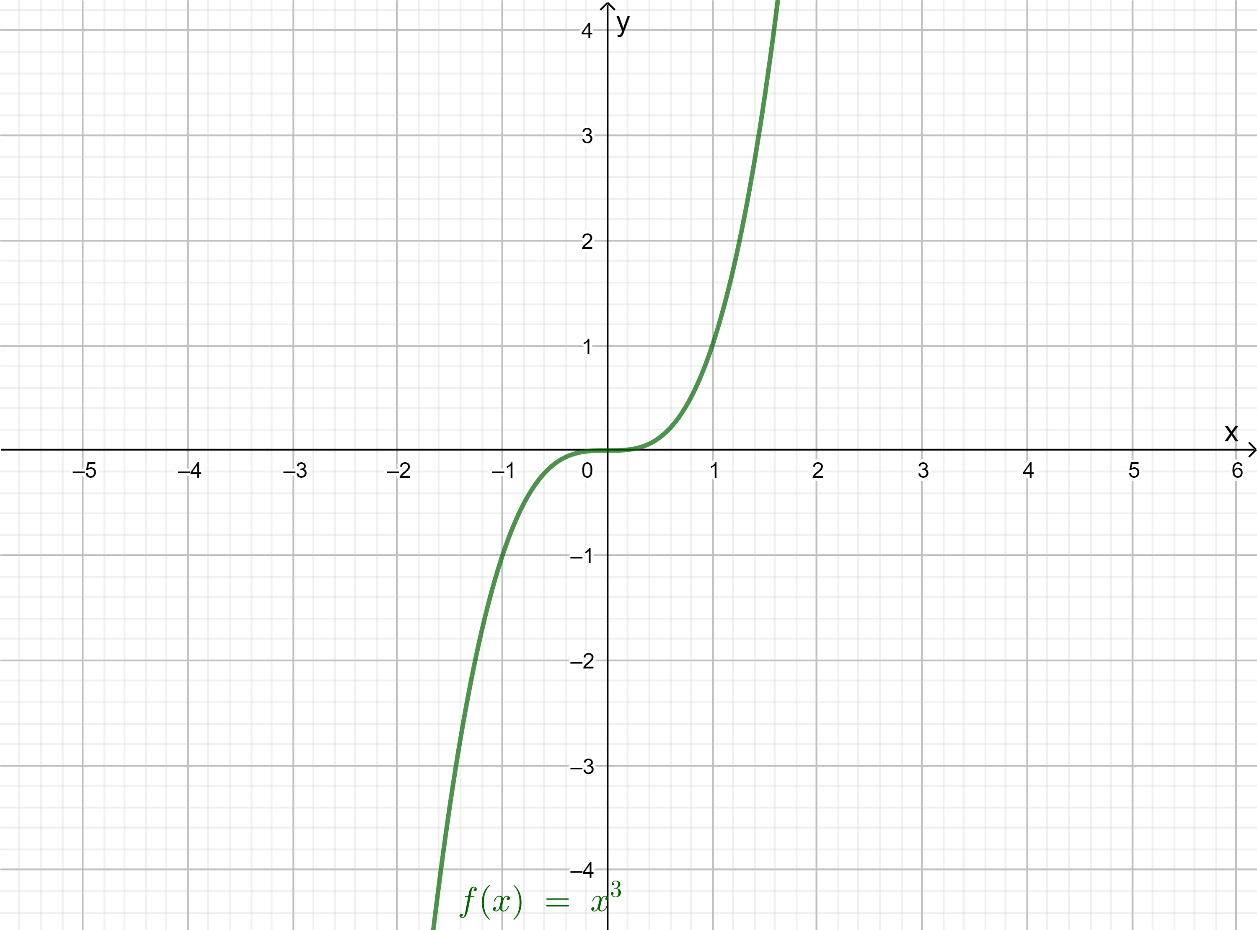
The given cubic function is of the form h(x)=a(1/b(x−h))3+k.
For g(x), h=0,k=0,b=1, and a=1/3.
Therefore, a<1. So, the graph will be compressed.
Thus, according to the rules of the cubic function h(x), the graph of g(x)=1/3x3 is the obtained by compressing f(x) vertically by a factor of 3.
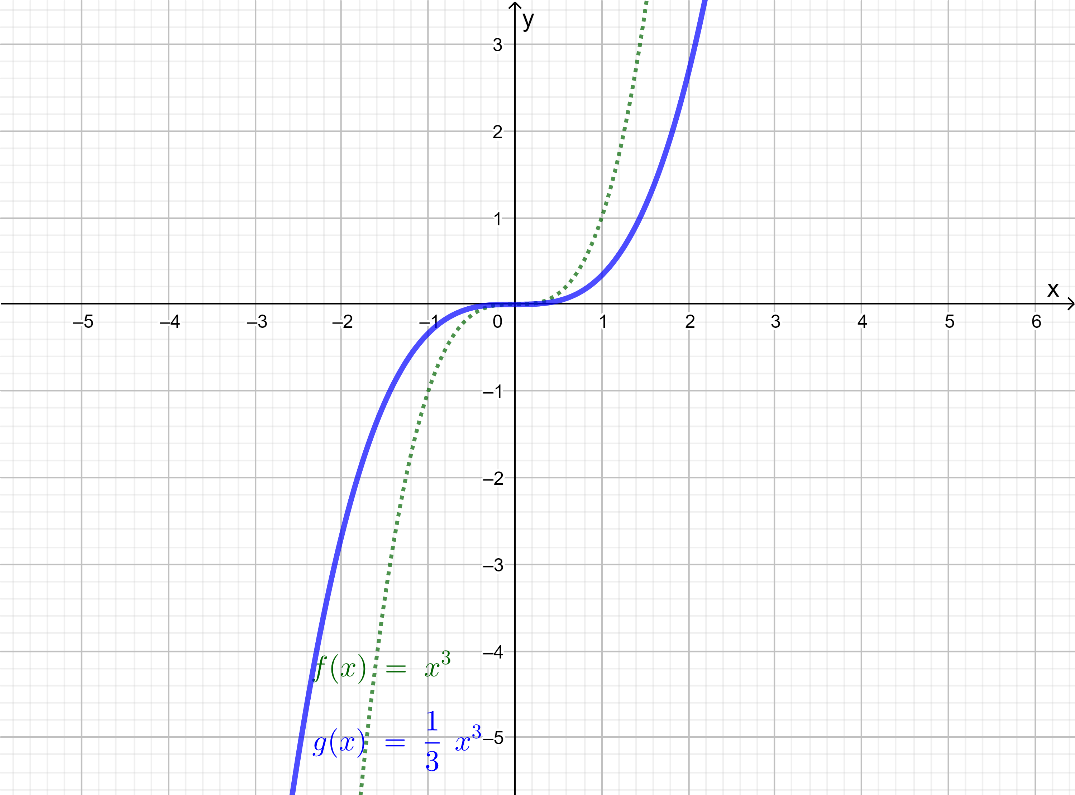
The vertical compression of f(x) by 3 units gives the graph of g(x)=1/4x3.
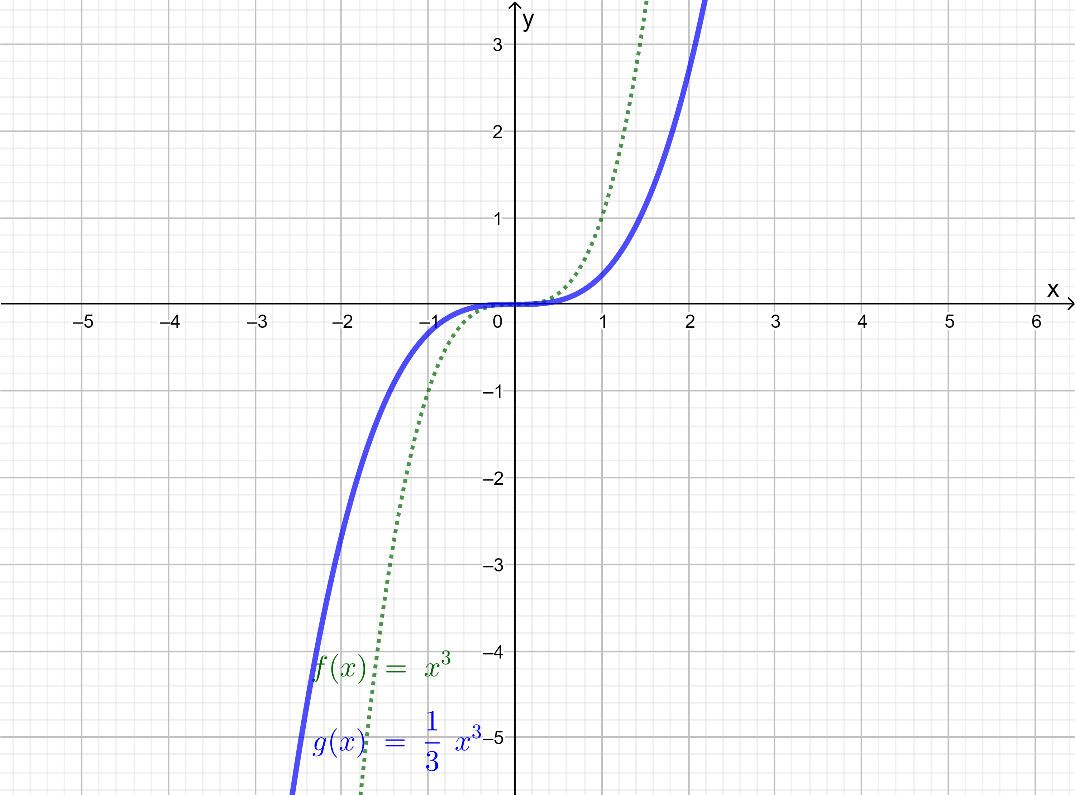
Page 244 Exercise 19, Answer
It is given that the function f(x)=x3 is getting transformed to the function g(x)=(x−4)3−3.
It is asked to identify the transformations then to draw the graph of the function by applying the transformations on the reference points (−1,−1), (0,0)and (1,1).
First, identify the transformations of the graph of f(x)=x3 that produces the graph of the function g(x), then draw the graph for function f(x).
Then apply those transformations in the reference points (−1,−1), (0,0)and (1,1), it will give the reference points for the new function g(x).
Plot those reference points and draw the smooth curve crossing over those points, the graph obtained will be the graph of the given function g(x).
The function f(x)=x3 is getting transformed to the function g(x)=(x−4)3−3.
The given function is of the form, h(x)=a(1/b(x−h))3+k.
For g(x), h=0,k=0, b=1, and a=1.
The transformations of the graph of f(x) that produces the graph of g(x) are Horizontal translation to the right by 4 units.
Vertical shift to the down by 3 units.
Note that, the Horizontal translation to the right by 4 units will only affect the x-coordinate and the Vertical shift to the down by 3 units will only affect the y-coordinate.

Now, plot the graph of the function f(x).
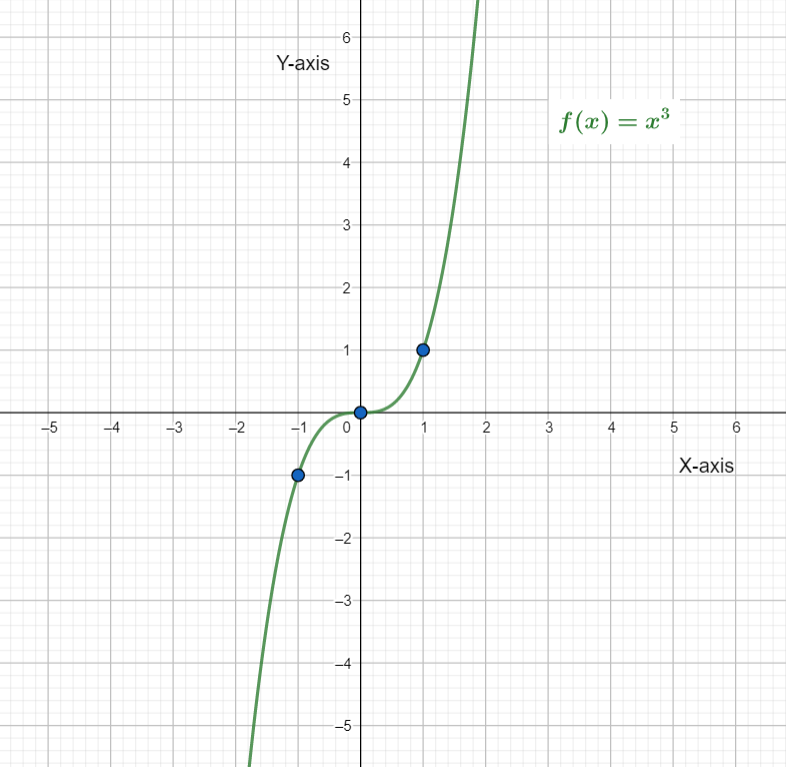
Then, shift the function f(x) to the right by 4 units and then to the down by 3 units to obtain the function g(x)
The transformations of the graph of f(x) that produces the graph of g(x) are:

Horizontal translation to the right by 4 units.
Vertical translation to the down by 3 units.
The graph of g(x) on the same coordinate plane as the graph of f(x) by applying the transformations to the reference points (−1,−1), (0,0) and(1,1) is given by,
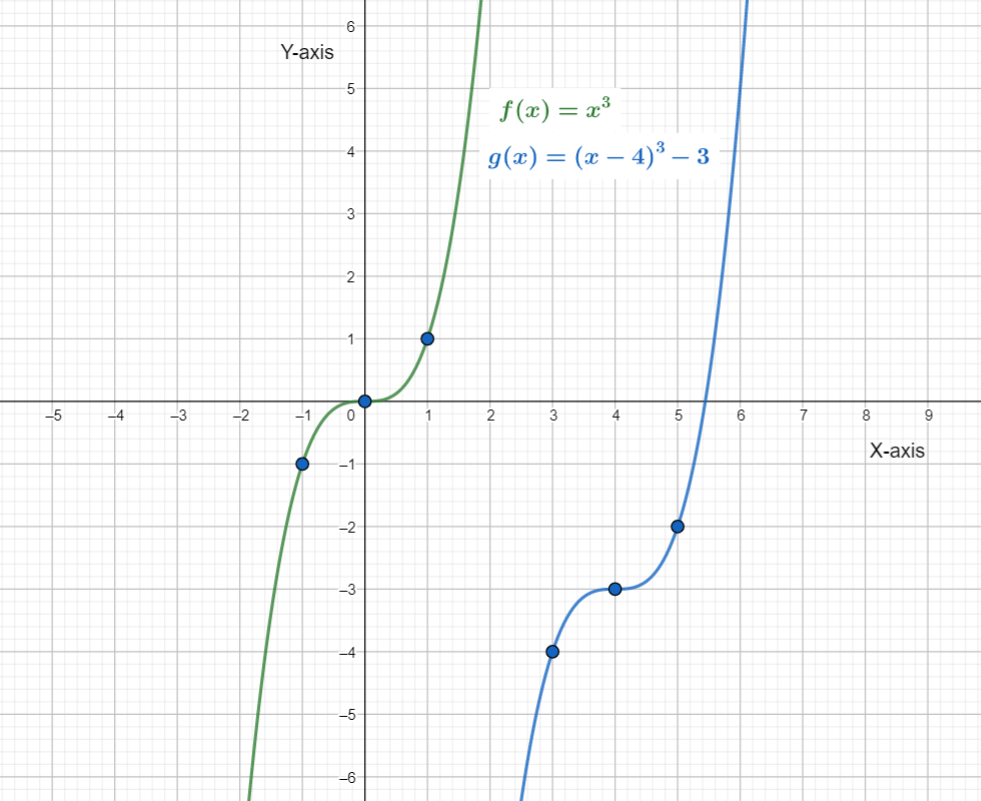
HMH Algebra 2 Volume 1 1st Edition Module 5 Chapter 5 Exercise 5.1 Polynomial Functions Page 244 Exercise 20, Answer
It is given that the function f(x)=x3 is getting transformed to the function g(x)=(x+1)3+2.
It is asked to identify the transformations then to draw the graph of the function by applying the transformations on the reference points (−1,−1)2,(0,0), and (1,1).
First, identify the transformations of the graph of f(x)=x3 that produces the graph of the function g(x), then draw the graph for function f(x).
Then apply those transformations in the reference points (−1,−1), (0,0), and (1,1), it will give the reference points for the new function g(x).
Plot those reference points and draw the smooth curve crossing over those points, the graph obtained will be the graph of the given function g(x).
The given function is of the form,h(x)=a(1/b(x−h))3+k.
For g(x), h=−1,k=2, b=1, and a=1.
The transformations of the graph of f(x) that produces the graph of g(x) are: Horizontal shifts to the left by 1 units.
Vertical shift to the upward by 2 units.
Note that, the Horizontal shifts to the left by 1 units will only affect the x-coordinate and the Vertical shift to the upward by 2 units will only affect the y-coordinate.

Now, plot the graph of the function f(x).
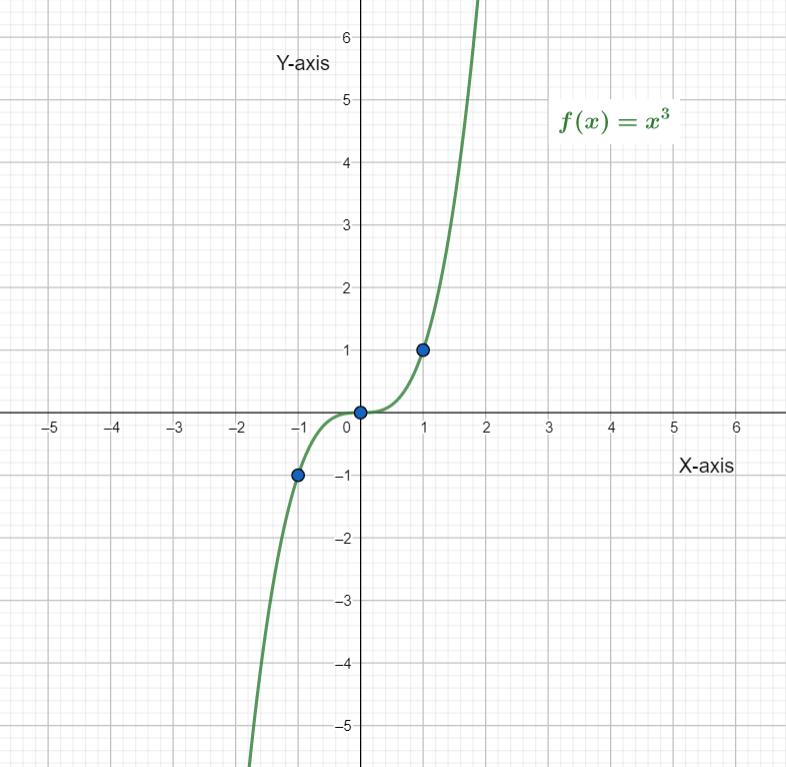
Then, shift the function f(x) to the left by 1 units and then to the upward by 2 units to obtain the function g(x).
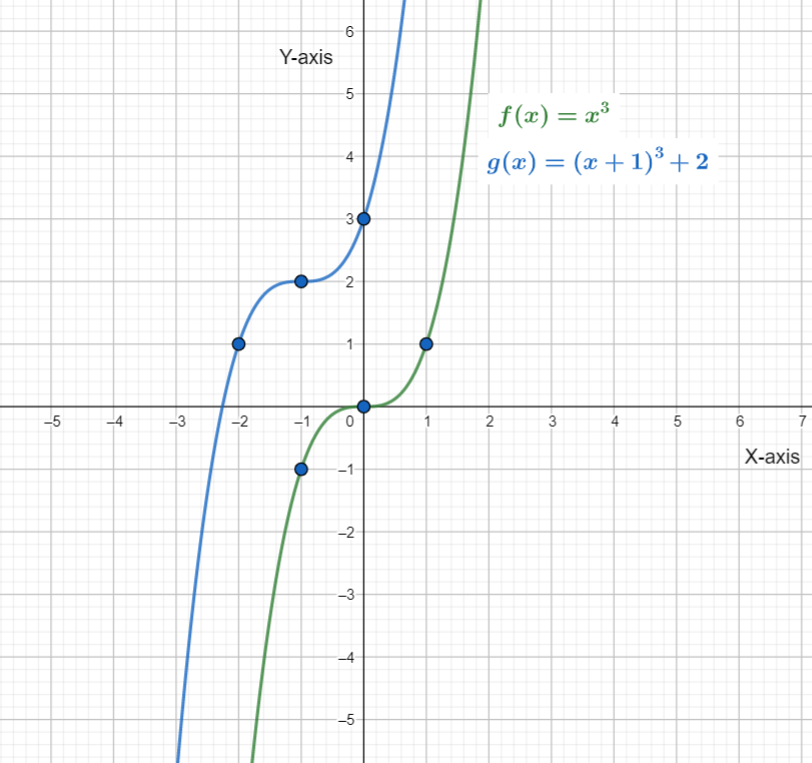
The transformations of the graph of f(x) that produces the graph of g(x) are: Horizontal shifts to the left by 1 units followed by vertical shift to the upward by 2 units.
The graph of g(x) on the same coordinate plane as the graph of f(x) by applying the transformations to the reference points (−1,−1), (0,0) and(1,1) is given by,

Page 244 Exercise 21, Answer
It is given that g(x)=a(x−h)3+k is a general equation for a cubic function and a graph of a function is given with its reference points.
It is asked to write a specific equation by identifying the values of the parameters from the reference points shown in the graph.
First of all, find the point of symmetry, in that, the abscissa is the value of h and the value of ordinate is the value of k.
Then to find the value of a, plug the values of h and k in the parent function and use another reference point to solve the equation.
Finally, substitute all the obtained values in the general equation for the cubic function, that will be the required function for the given graph.
First, identify the point of symmetry from the graph.
(h,k)=(1,4)
Thus, h is equal to 1 and k is equal to 4.
Now, identify the value of a by substituting the values of h, k and using any of the reference point in the general equation.
Therefore, g(x)=a(x−h)3+k
Substituting 1 for h and 4 for k.
g(x)=a(x−1)3+4
Consider the references points (0,7) and substitute 0 for x and 7 for g(x).
7=a(0−1)3 +4
7=a(−1)+4
7=−a+4
Subtract 4 from both the sides.
7−4=−a+4−4
3=−a
Multiply both sides by −1 and rewrite the equation for a.
3(−1)=−a(−1)
a=−3
Thus, a is equal to −3.
Now, substitute all these values in the given general equation of the cubic functiong(x)=a(x−h)3+k.
Thus, g(x)=−3(x−3)3+4
Hence, the required equation for the given function is g(x)=−3(x−3)3+4.
The specific equation by identifying the values of the parameters from the reference points shown in the graph is given by g(x)=−3(x−3)3+4.
HMH Algebra 2 Volume 1 1st Edition Module 5 Chapter 5 Exercise 5.1 Polynomial Functions Page 244 Exercise 22, Answer
It is given that g(x)=(1/b(x−h))3+k is a general equation for a cubic function and a graph of a function is given with its reference points.
It is asked to write a specific equation by identifying the values of the parameters from the reference points shown in the graph.
First of all, find the point of symmetry, in that, the abscissa is the value of h and the value of ordinate is the value of k.
Then to find the value of b, plug the values of hand k in the parent function and use another reference point to solve the equation.
Finally, substitute all the obtained values in the general equation for the cubic function, that will be the required function for the given graph.
First identify the point of symmetry from the graph.
(h,k)=(2,−1)
Thus, h is equal to 2 and k is equal to −1.
Now, identify the value of b by substituting the values of h, k and using any of the reference point in the general equation.
Therefore, g(x)=(1/b(x−h))3+k
Substituting 2 for h and −1 for k.
g(x)=(1/b(x−2))3+(−1)
Consider the references points (1.5,0) and substitute 1.5 for x and 0 for g(x).
0=(1/b(1.5−2))3 +(−1)
0=(1/b(0.5))3−1
0=1/b3(0.5)3−1
0=0.125/b3−1
Add 1 to both the sides.
0+1=0.125/b3
−1+1 /1=0.125/b3
Multiply both sides by b3.
1=0.125/b3
1⋅b3=0.125
b3⋅b3 b3=0.125
Take cube root of both the sides.
3√b3=3/√0.125
b=0.5
Thus, b is equal to 0.5.
Now, substitute all these values in the given general equation of the cubic function g(x)=(1
b (x−h))3+k.
Thus, g(x)=(1/0.5(x−2))3+(−1)
g(x)=(1/0.5(x−2))3−1
Hence, the required equation for the given function is g(x)=(1/0.5(x−2))3−1.
The specific equation by identifying the values of the parameters from the reference points shown in the graph is given by g(x)=(1/0.5(x−2))3−1.
Page 244 Exercise 23, Answer
It is given that the density of gold is 0.019kg/cm3.
It is asked to estimate the edge length of a cube of gold with a mass of 1 kg by modeling a cubic function and graphing the function using calculated values of the function.
Consider the length as l, then find volume, mass of the gold. Then draw a graph using the mass function with plots mass vs. length.
From the graph, find the value in the X−axis which is the length of the cube of the gold, for mass equal to 1, that will be the required value.
Given that the density of gold is 0.019 kg/cm3.
Assume the length of the edge of the cube be l (in cm). Then, volume of the cube is given by,
V=l3cm3
Since density of the gold is given as 0.019kg/cm3
Therefore, mass of the cube is,
m=Vd
m=0.019l3 kg
Now, make a table using the above function.

Draw the graph of the mass function by plotting above points, and recognizing that the graph is a vertical compression of the graph of the parent cubic function by a factor of 0.019.
Then draw the horizontal line m=1 and estimate the value of l where the graph intersects.
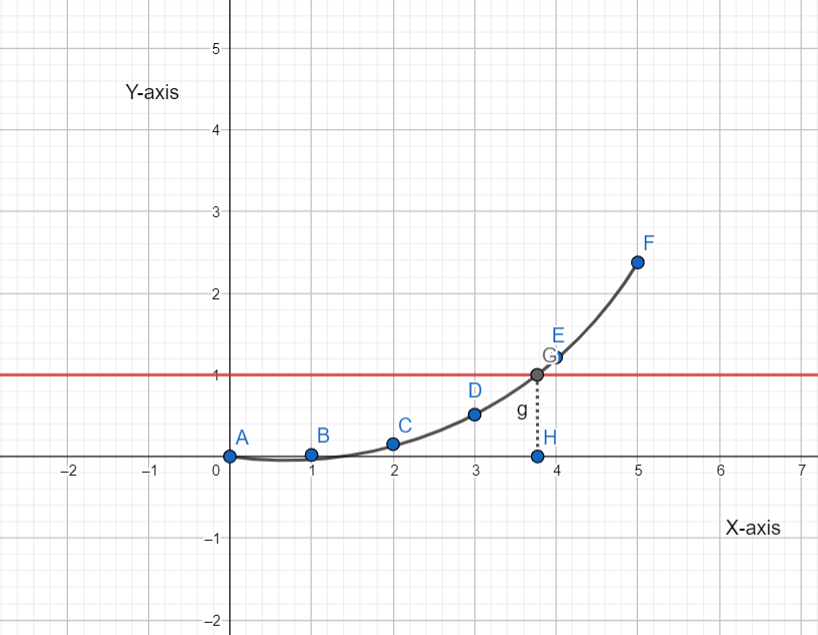
This is given to be 1kg. Thus, 0.019x3=1
Divide both sides by 0.019.
0.019x3/0.019=1
0.019 x3 =1
0.019x3 =52.63
Take cube root of both the sides.
3 √x3 =3
√52.63
x=3.74 cm
Hence, edge length of a cube of gold is 3.74 cm.
The edge length of a cube of gold is 3.74 cm.
HMH Algebra 2 Volume 1 Exercise 5.1 Walkthrough
HMH Algebra 2 Volume 1 1st Edition Module 5 Chapter 5 Exercise 5.1 Polynomial Functions Page 244 Exercise 24, Answer
It is given that a proposed design for a habitable Mars colony is a hemispherical biodome used to maintain a breathable atmosphere for the colonists.
It is asked to estimate the radius of the biodome if it is required to contain 5.5 billion cubic feet of air, by modeling a cubic function and graphing the function using calculated values of the function.
Consider the length as l, then find volume, mass of the gold. Then draw a graph using the mass function with plots mass vs. length.
From the graph, find the value in the X−axis which is the length of the cube of the gold, for mass equal to 1, that will be the required value.
Assume the radius of the hemispherical biodome ber (in foot).
Then, volume of the hemispherical biodome is given by,
V=2/3πr3 feet3
This is given to be 5.5 billion cubic feet.
Thus, 5.5=2/3πr3
Multiply both sides by 3/2π and simplify the equation.
5.5⋅3/2π=2
3/πr3⋅(3/2π) 2.62=r3
r3=2.62
Take cube root on both the sides and simplify the equation.
3√r3=3√2.62
r=1.37
Hence, radius of the biodome is 1.37 thousands of feet.
The radius of the hemispherical biodome is 1.37 thousands of feet.
HMH Algebra 2 Volume 1 1st Edition Module 5 Chapter 5 Exercise 5.1 Polynomial Functions Page 244 Exercise 25, Answer
It is given that the graph of the function f(x)=x3 is been stretched.
It is asked to explain that how horizontally stretching the graph of the function by a factor b can be equivalent to vertically compressing the graph of the same function by a factor a.
Since, a horizontal stretching by a factor can be accomplished by the graph of,
f(x)=(1/bx)3
f(x)=1/b3x3
Thus, horizontal stretching by a factor of b is equivalent to the vertical compression by a factor of b3.
Page 248 Exercise 26 Answer
It is given that Julio wants to purchase a spherical aquarium and fill it with salt water, which has an average density of 1027g/cm3
Also, he has found a company that sells four sizes of spherical aquariums whose size and diameter is represented by the table

It is required to find that if the stand for Julio’s aquarium will support a maximum of 50kg , what is the largest size tank that he should buy
To find the required answer find the volume with the density of 1027g/cm3 and mass of 50kg by the equation d=m/v
Then, equate the obtained volume with 43πr3and find the radius Double the radius to get the diameter then choose the appropriate size according as the obtain diameter
The density of the salt water is 1.027g/cm3
The aquarium will support a maximum of 50kg or
50×1000=50000g
The formula of volume in terms of density is v=m/d
v=500001027=48685
Thus, the volume is 486855cm3
Equate the obtained volume with the formula of volume of a sphere4
3πr3 to find the radius
4/3πr3
=486855
Multiply both side with 3/4
πr3
=486855×3/4
=36514125
Since π=22/7
so multiply both side with722
227×722×r3
=36514125×722r3
=1161813r3
=(2264)3
Thus, the value of ris 2264
Find the diameter
Multiply the radius obtained by 2
Diameter=2254×2
=4528 cm
≈45 cm
Now, on comparing the obtained diameter with the given diameter according as the size of aquarium, the largest size tank is the large size of 45 cm diameter that should be buy
The largest size tank that he should buy should have 45 cm diameter
Page 248 Exercise 27, Answer
It is given that Julio wants to purchase a spherical aquarium and fill it with salt water, which has an average density of 1027g/cm3
Also, he has found a company that sells four sizes of spherical aquariums whose size and diameter is represented by the table is inferred from part (a) that he should buy is the large size of 45 cm diameter if the stand for Julio’s aquarium will support a maximum of 50kg with the density of 1027g/cm3

It is required to find whether the suggestion of friend is correct or not Julio’s friend suggests that he can buy a larger tank if he uses fresh water, which has a density of 10 g/cm3
It To find the required answer find the volume with the density of 10 g/cm3 and mass of 50kg by the equation d=mv
Then equal the obtain volume with 4/3πr3and find the radius Twice the obtain radius to get the diameter then choose the appropriate size according as the obtain diameter
Then compare the obtain diameter for both the density 1027g/cm3 and 10 g/cm3to fin the suggestion of Julio’s friend is logical or not
The density of the water is 10 g/cm3
Aquarium will support a maximum of 50kg or50×1000=50000 g
The formula of volume in terms of density is v=md
Substitute m as 50000 g and d as 10 g/cm3
v=5000010=50000 cm3
Thus, the volume is 50000 cm3
Equate the obtained volume with the formula of volume of a sphere 43πr3to find the radius
43πr3=50000
Multiply both side with 3/4 and substitute π=22/7πr3
=50000×3/4
=37500
Multiply both sides by 7/22
227×7
22×r3
=37500×7
22r3=1193181r=(2285)3
Find the diameter
Multiply the radius obtained by 2
Diameter=2285×2
=457 cm
The diameter of the tank is 457 cm when fresh water is used
Observe that the diameter of the largest tank Julio could buy is 45 cm
Thus, when freshwater has used the diameter of the Tank is slightly greater Therefore, the suggestion of the friend is correct
The suggestion made by the friend that Julio could buy a larger tank if he uses freshwater of density 10 g/cm3is correct because the diameter of the tank when freshwater is used is 457 whereas the tank he bought earlier was of 45 cm diameter
